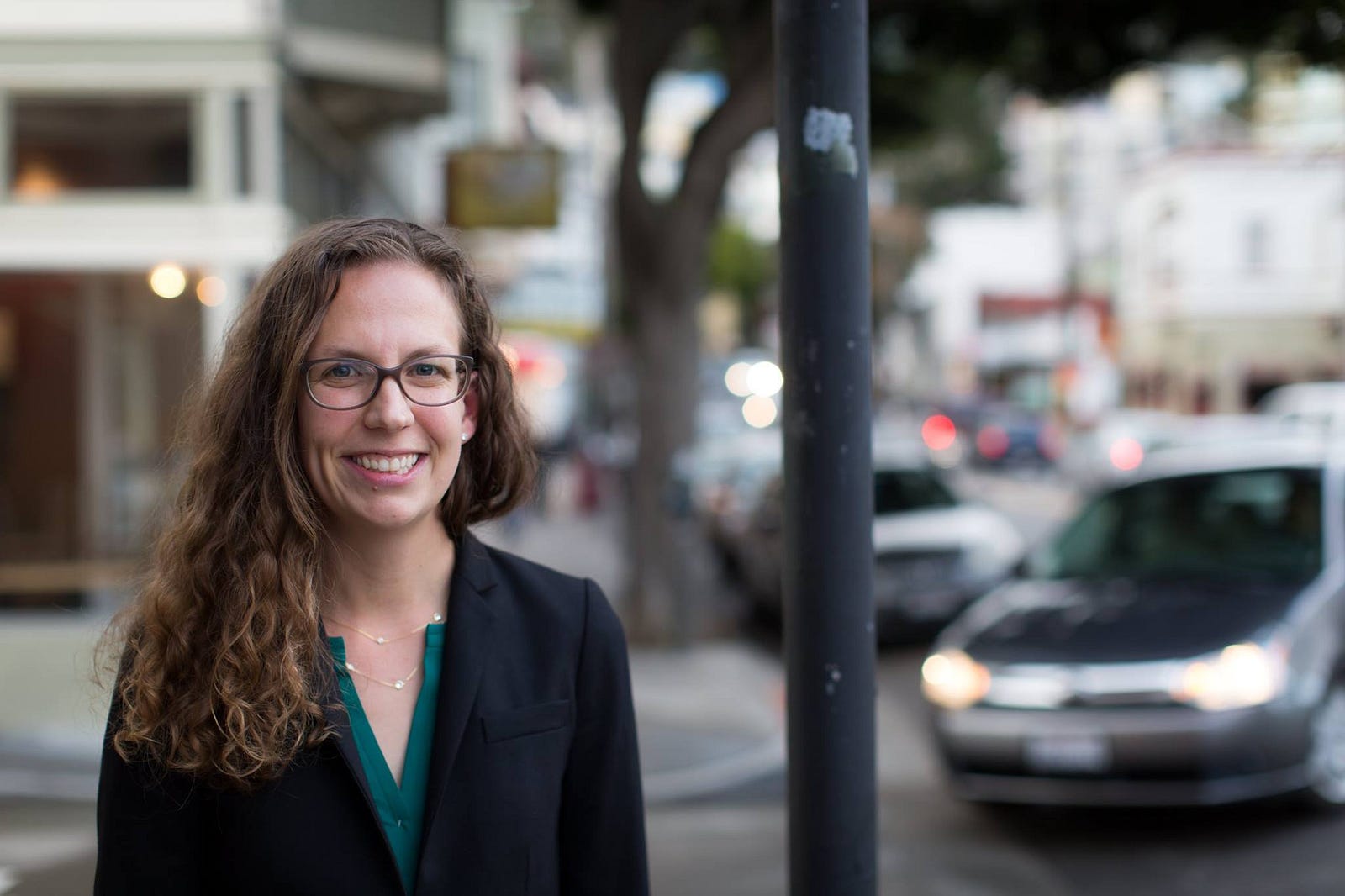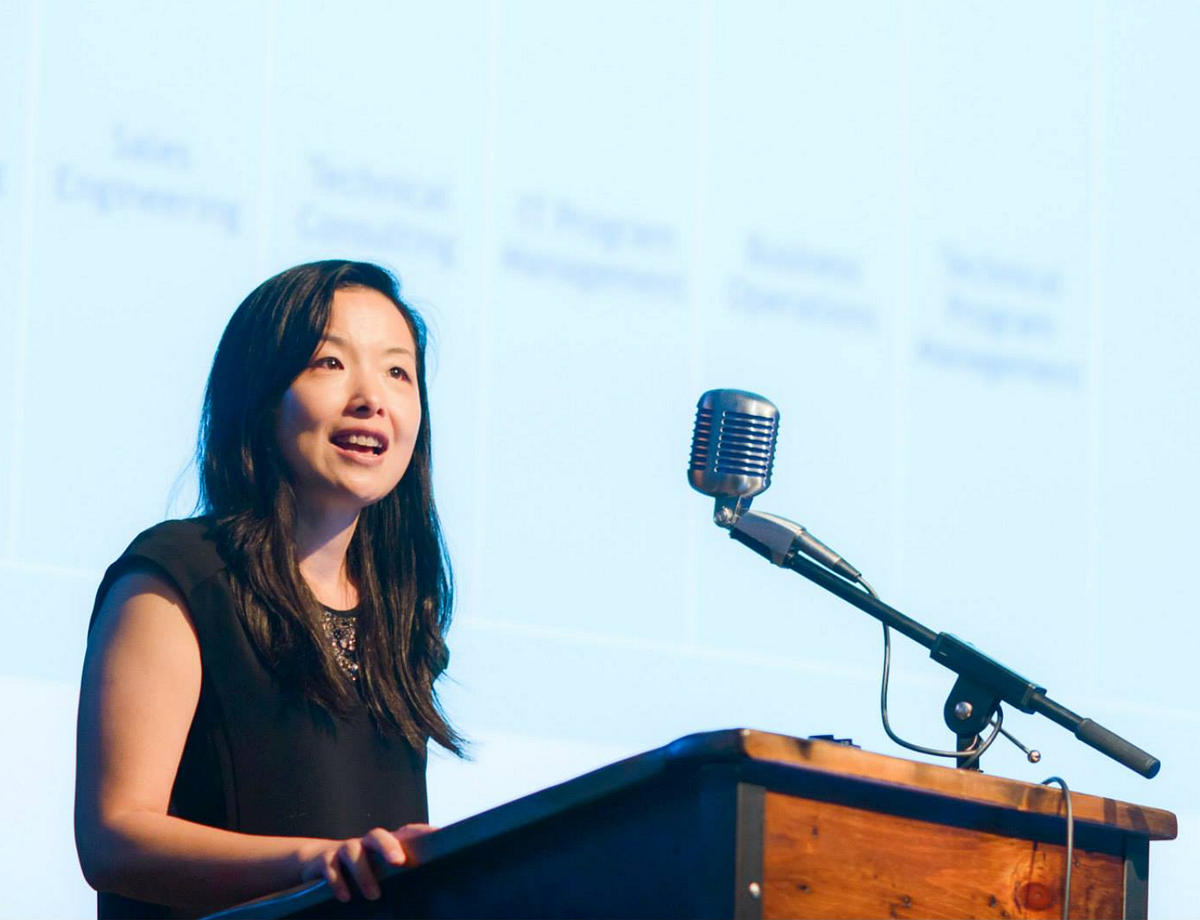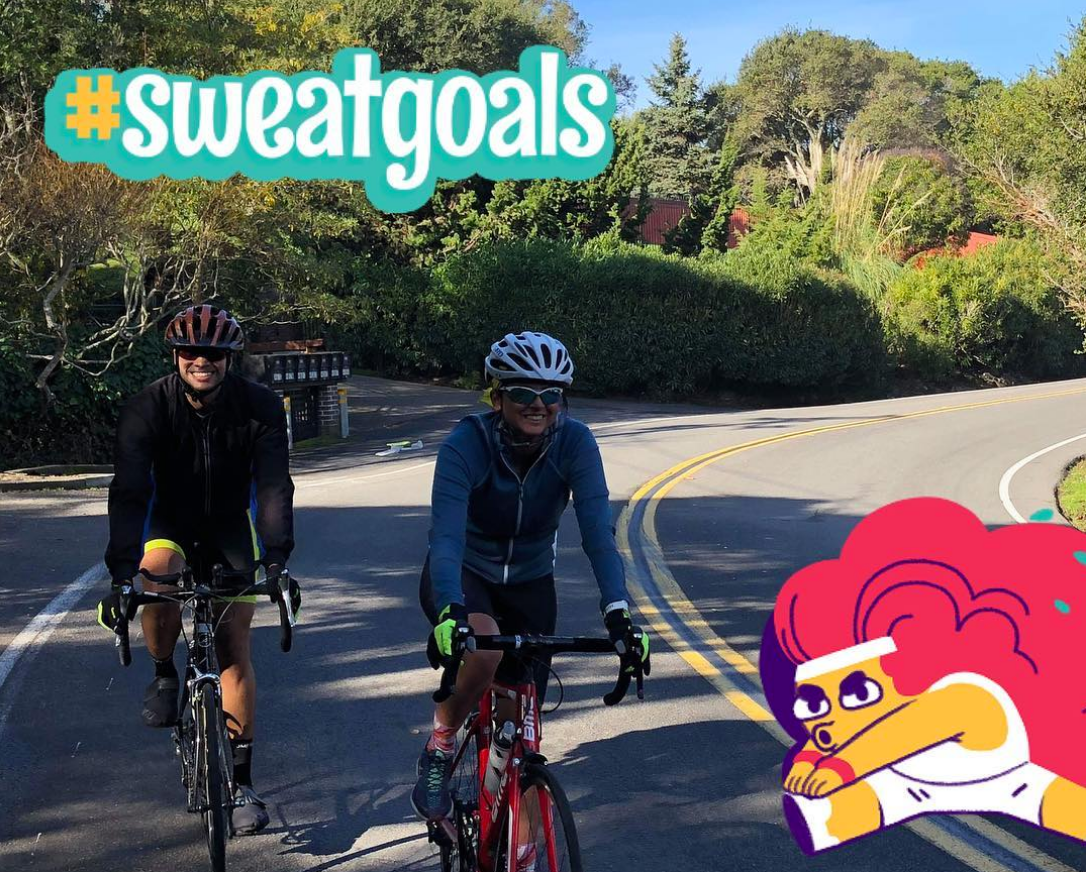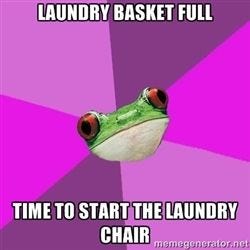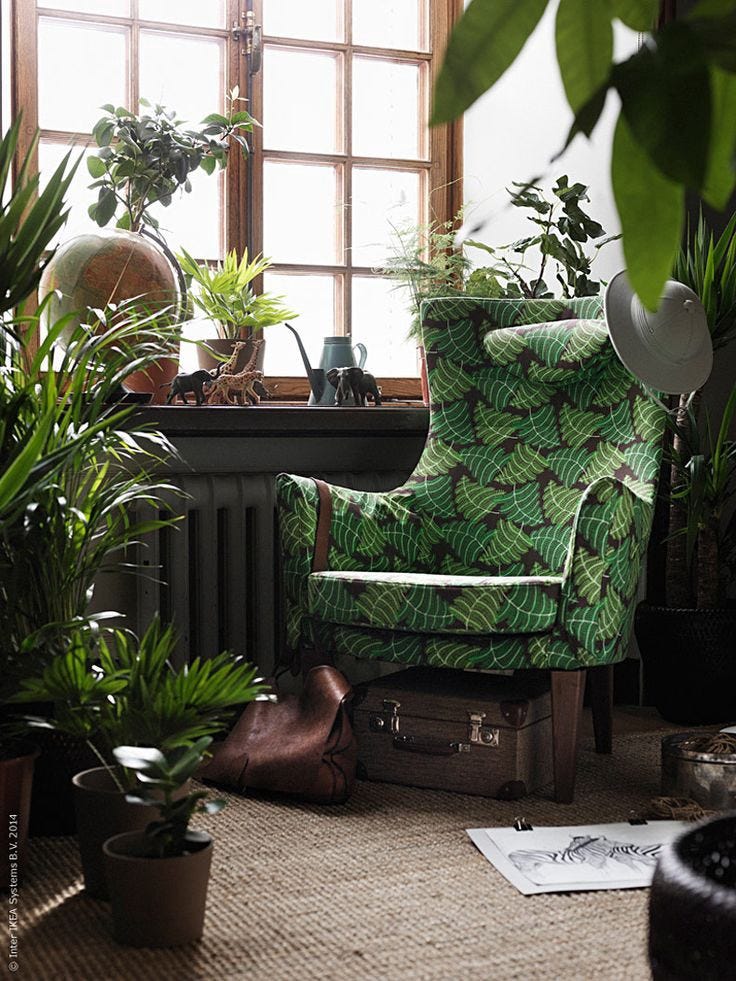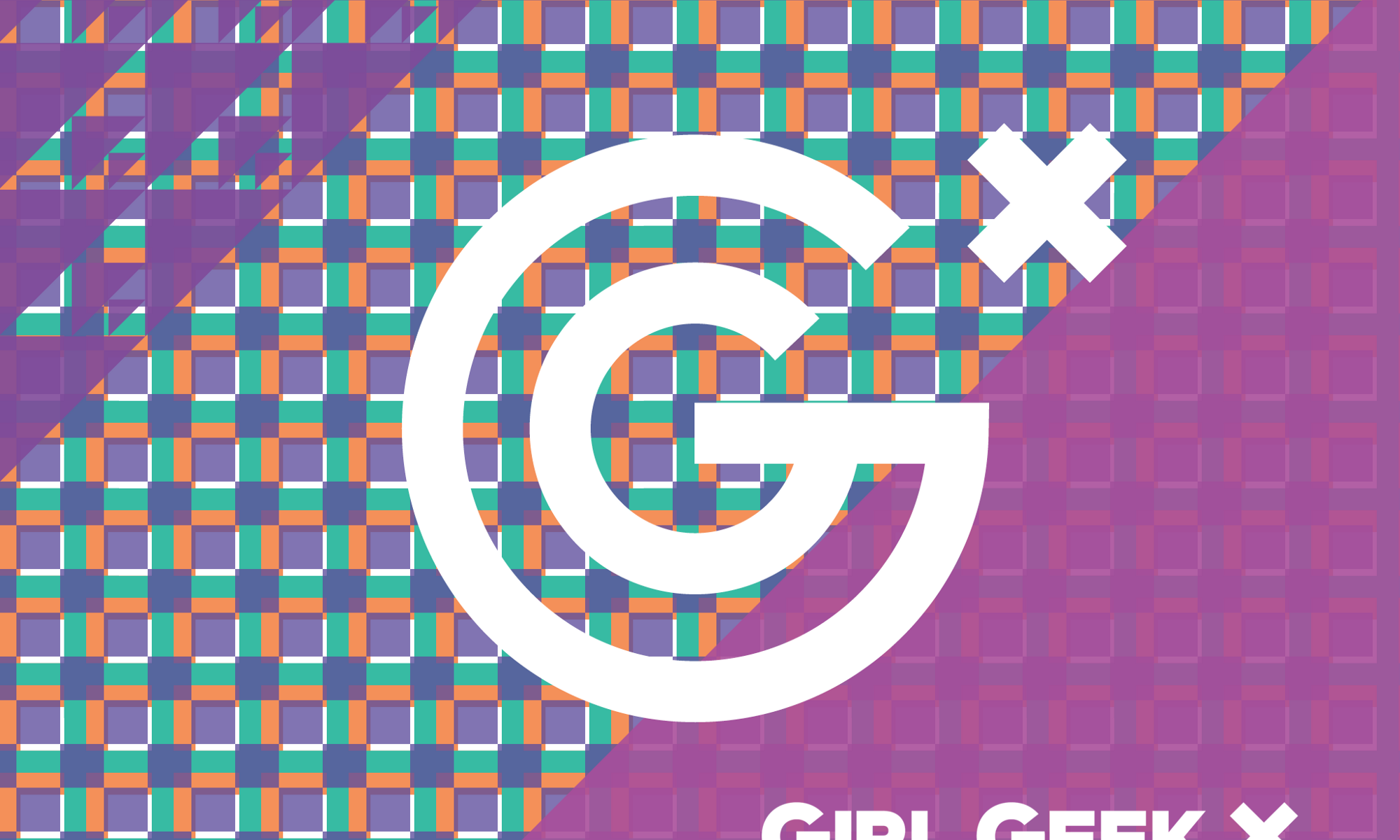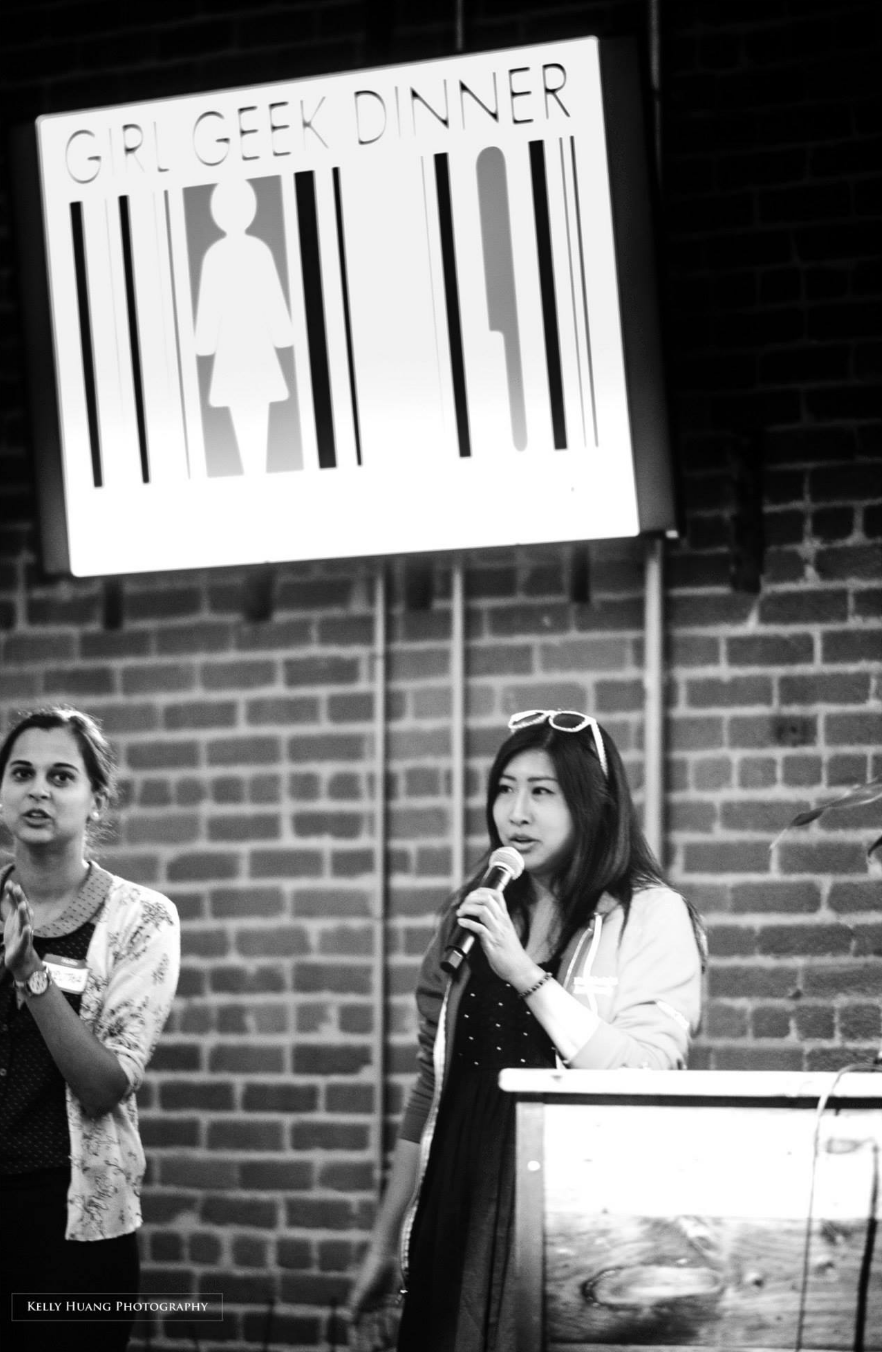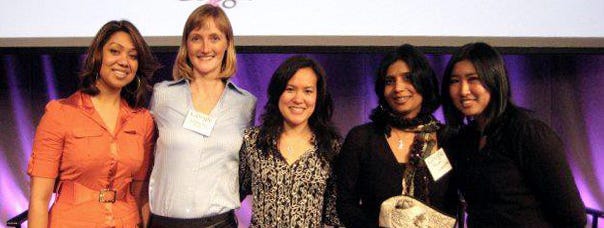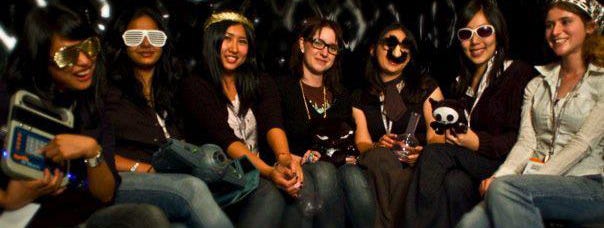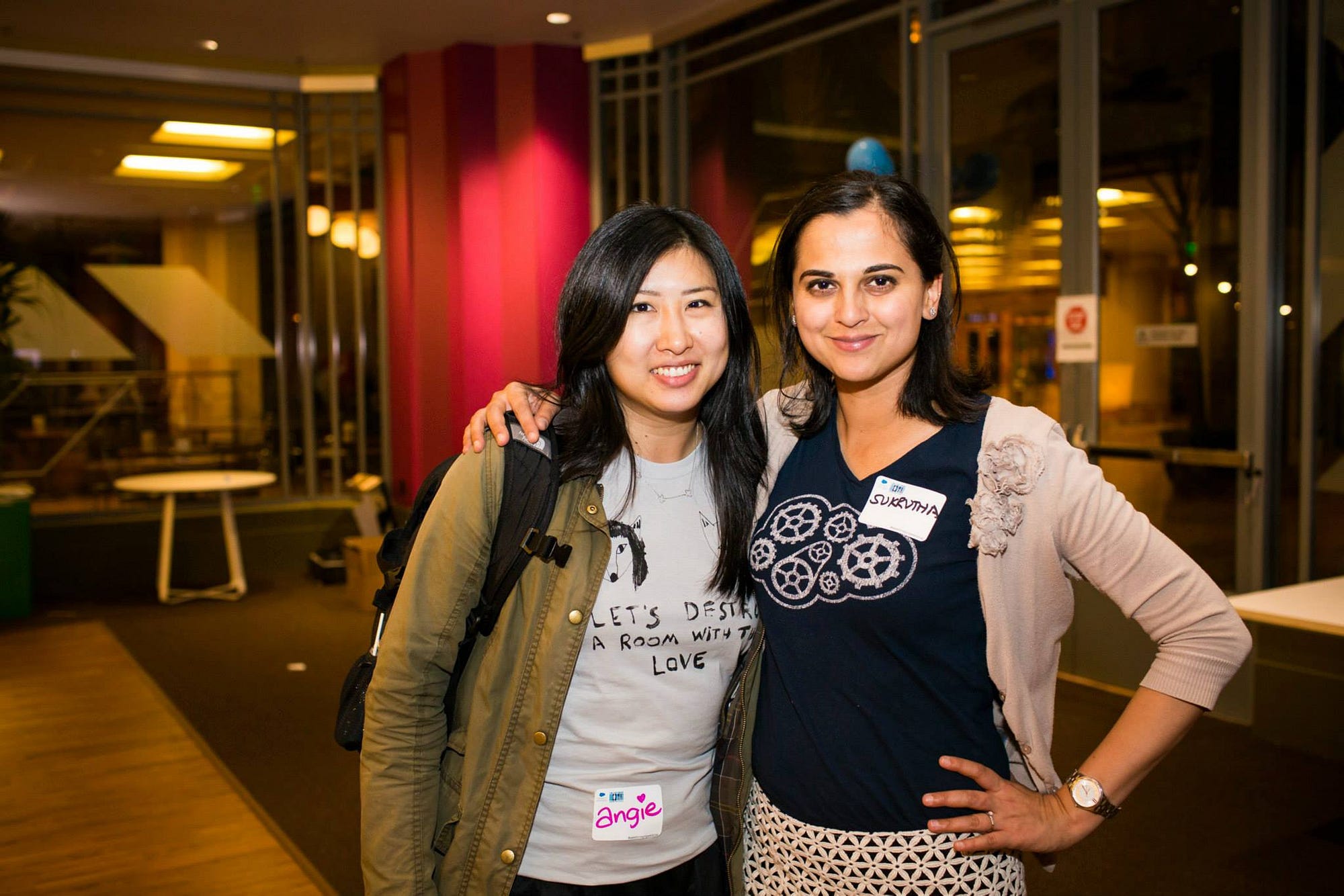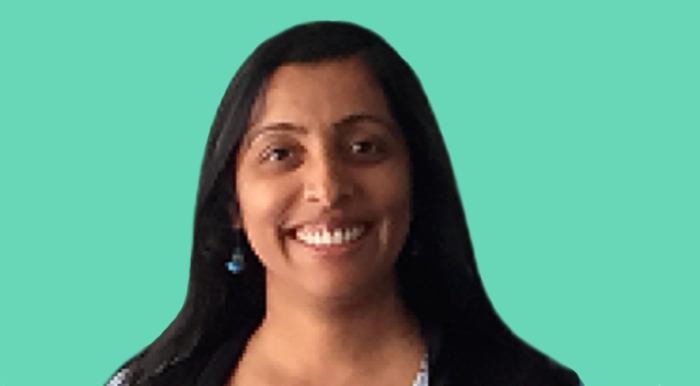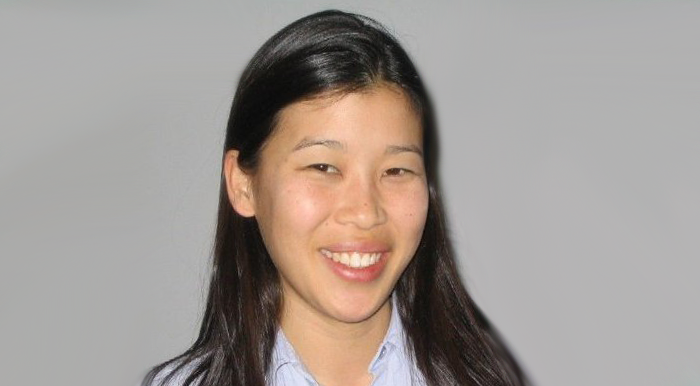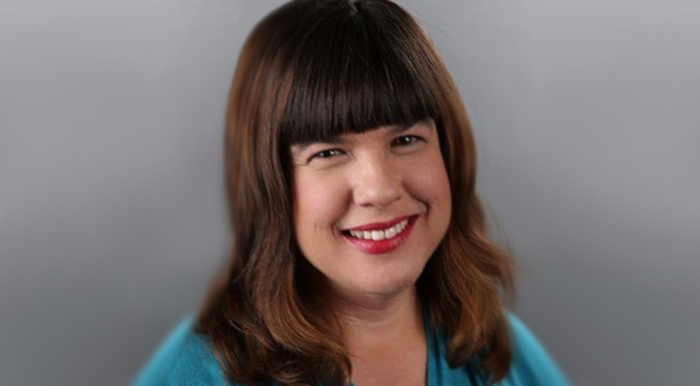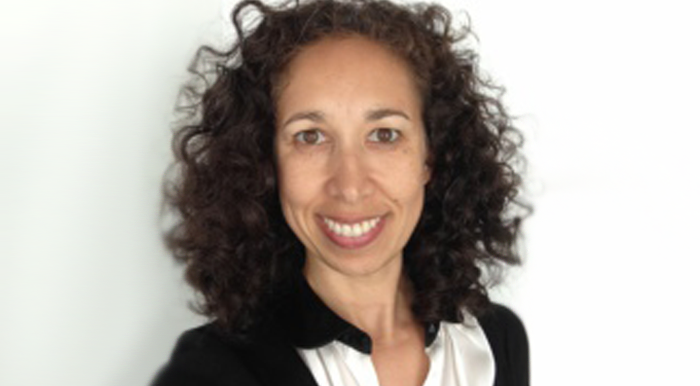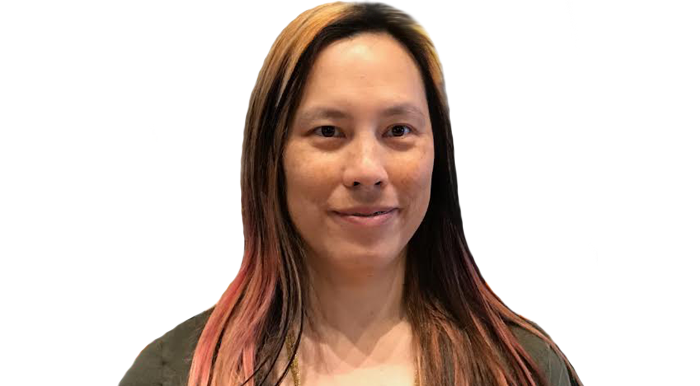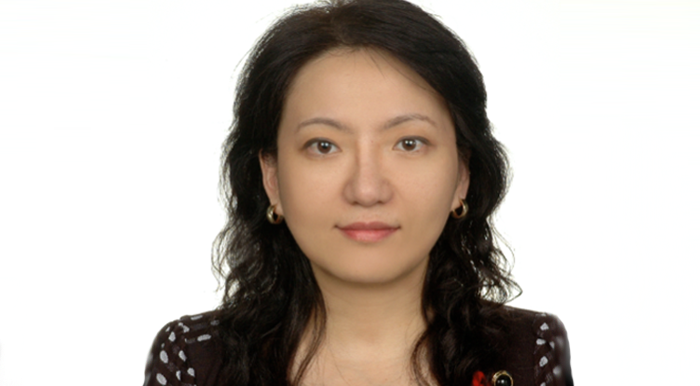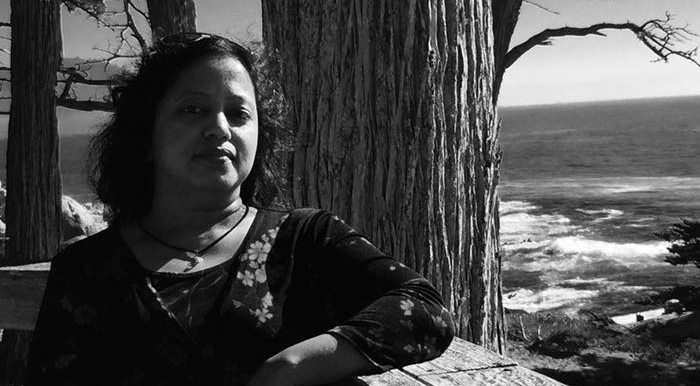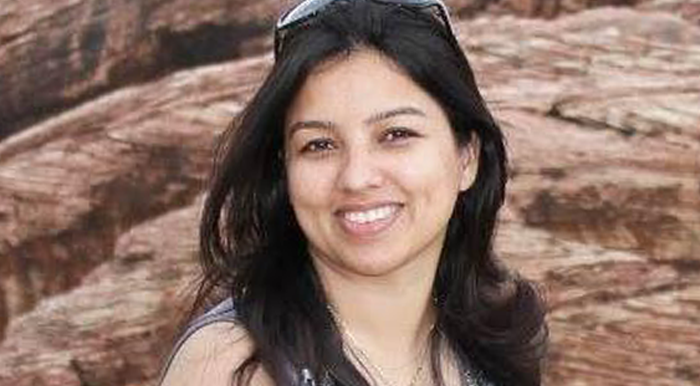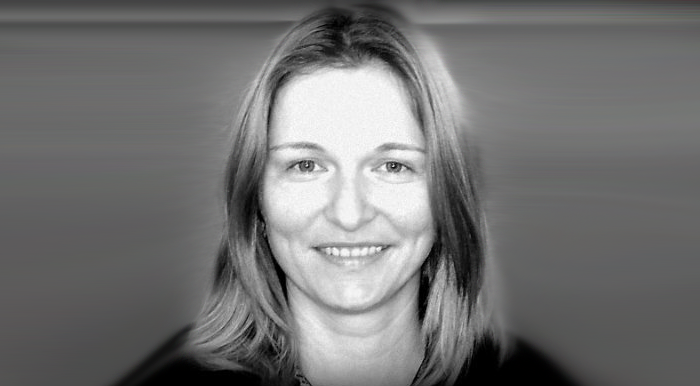Like what you see here? Our mission-aligned Girl Geek X partners are hiring!
- See open jobs at Branch and check out open jobs at our trusted partner companies.
- Does your company want to sponsor a Girl Geek Dinner in 2021? Talk to us!
Speakers:
Mada Seghete / Co-Founder & Head of Marketing / Branch
Zeesha Currimbhoy / Director, Engineering / Branch
Deepikaa Subramaniam / Senior Software Engineer / Branch
Javeria Khan / Systems Engineer / Branch
Ann Massoud / Strategic Partner Growth / Branch
Transcript of Branch Girl Geek Dinner – Lightning Talks & Panel:
Mada Seghete: I’m Mada. I’m one of the founders of Branch, and I’m incredibly excited for our panel tonight. We have three amazing engineers and myself, a quasi-engineer. I used to be an engineer, and now, I kind of … I don’t do engineering anymore, but I’ll tell you about my story from engineering to where I am today. Yeah.
Mada Seghete: We’re going to have four talks and then a Q&A session and then some more mingling after. We start with Zeesha, who’s our director of engineering, and she’s incredible. Can’t wait for you to hear her story.
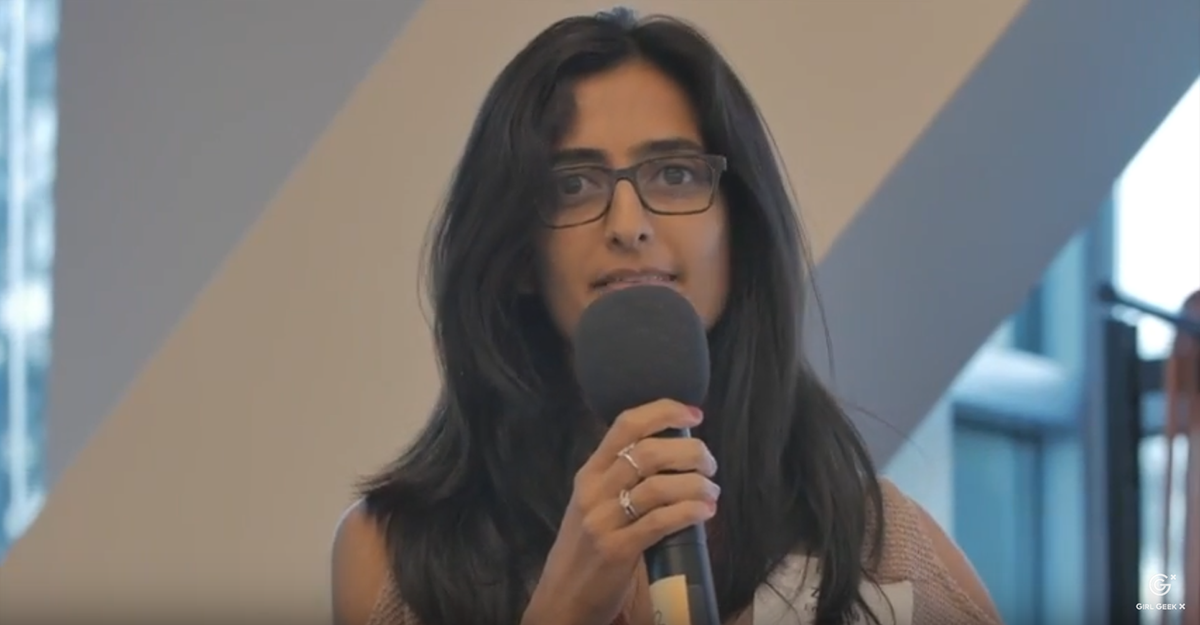
Director of Engineering Zeesha Currimbhoy speaking at Branch Girl Geek Dinner in Redwood City, California.
Zeesha Currimbhoy: Great. Can everyone hear me okay at the back? Thumbs up if you can hear me. Great. Thank you. I’m Zeesha. I’m one of the directors of engineering here at Branch. Who am I? I thought I’ll start off with a little blurb about who I am.
Zeesha Currimbhoy: On a more professional level, I’m currently a director at Branch where I run part of the engineering team. I’m responsible for the product backend team. I am running a search and discovery initiative where we’re basically building a pretty cool search product. I’m also responsible for part of the most of the data science organization. I’ve been at Branch over two years now, worn multiple hats just like you would at a startup, been in several roles, worked with a lot of different people. I think Branch has given me everything that I’ve been looking for so far.
Zeesha Currimbhoy: On a more personal note, I’m a daughter. I’m a wife. I’m a philanthropist by heart. I’m a mother of two adorable children, Sarah who’s four, that little one there, and Rehan who is a little over a year old. Fun fact, I had both of my kids while working at startup, so if ever anyone’s curious or is trying, just planning to start a family and is in engineering or is in a startup, feel free to come chat with me later. We can discuss everything around that.
Zeesha Currimbhoy: Last night, I was basically thinking about what I’m going to talk about, and I was reflecting on my career, and I said, “You know what, what’s kind of gotten me here? What’s made me successful?” The thing that resonated the most about this, about my journey and the thing I wanted to share with all of you is I truly believe that the thing that stands between each one of us, everyone in this room, me and every human, the thing that stands between us and success is really the fear of failure.
Zeesha Currimbhoy: The fear of failure prevents us from taking risks. It prevents us from exploring new opportunities. When I talk about failure, it’s something as simple as being scared to raise your hand in a room full of men and being able to ask that question that’s been nagging you right through because, well, you fear sounding stupid.
Zeesha Currimbhoy: How many of us have been in that situation? I most definitely have. I don’t know how many of you all have, but it’s the most common thing ever, is the fear of perception, of how people perceive us, holds us back from actually being ourselves and actually being successful.
Zeesha Currimbhoy: A little bit about my background, I was working in Evernote a long time ago, probably eight years ago and was incredibly successful there. I used to run … I was the technical leader, very comfortable in my role, and then all of a sudden, I decided I’m done with this company. I want to basically work on a product that I can impact many people’s lives. I want to work on something that people can relate to. I want to point to something and say I built that. I interviewed at only one company or a couple of companies, but I decided to take up an offer at Evernote. I was going to join their backend team, which was my experience and expertise.
Zeesha Currimbhoy: Then, a day later, the manager who I was going to report into the calls me up, and says, “You know what, we’re starting this new team. It’s called the data products team. It’s like an AI team, and we want you to be the first engineer on it.” I was like, “Oh my God, I’ve never done that before. Don’t know the space. Never done mobile development. Not worked with any Mac clients or iOS clients.” Very out of my background. I was almost going to say no. I actually said no to him. He called me a day later and said, “You know what, you interviewed really well with us. We think that you have great potential. This is an opportunity for you. Don’t let it go.”
Zeesha Currimbhoy: I thought about that, and I was very afraid to take that risk, right? It’s completely out of my comfort zone. I was going from 100,000-plus-person company to like now, a 50-person company and the first engineer of a team that they’re actually building out a strategic arm around, but I decided to take the opportunity.
Zeesha Currimbhoy: I decided to overcome that fear because I asked myself one simple question. What’s the worst that can happen? What’s the worst that’s going to happen if I take this role? The more I thought about this, I kept asking myself. I said, well, you know what, I can get fired. I can lose my job. So, what? Well, then, I’ll be out of a job. So, what? I’ll find another job, but if I don’t take this, I wouldn’t know what is on the other side, and so I decided to take that. I ended up running their search team. Eventually, I built all of their Mac lines search out right from iOS to Android, and it was an opportunity that I never regret having taken.
Zeesha Currimbhoy: Similarly, a year later from their … A year or two later, the same manager who I reported to who decided to take this risk on me, he got me in a room with the CEO and said, “You know what, we want you to actually be the VP of the augmented intelligence team, the team that we’re betting the whole company on.” I sat there looking at him and said, “You got to be crazy.”
Zeesha Currimbhoy: It was such an incredible opportunity. I’m pretty sure all of you are thinking, “Well, why would anyone say no to that? That’s such an amazing opportunity,” but what it meant for me was being an engineer, having operated in a leadership role, I would now be responsible for strategic direction, vision, planning, road mapping, responsible for the career of 20 plus people who are all researchers, PhDs, machine learning engineers, a skill that I didn’t have. I could sit there and find 100,000 reasons why I shouldn’t have done that because I just felt that I wasn’t qualified for the job, but someone took that risk on me. Someone put that bet on me. Someone said that, “You have the potential to do this, and you can do it, and we believe in you.” Then, why didn’t I believe myself?
Zeesha Currimbhoy: I decided after many conversations with my manager at that point, he was the best manager I ever, ever, ever reported into, I decided to take that opportunity. The path forward was amazing. It was challenging. It definitely had its share of challenges. There were several products that I led from ground up, came up with … If ever any of you all have used the Mac line, a lot of their intelligent products were things that I had come up with, but behind all of those products, there were several failed attempts. Those are the ones that people don’t realize because they fail, people don’t even know they exist, and then you find something else.
Zeesha Currimbhoy: Behind each one of those, behind each one of those stories was a failure, a story of failure, a story of hard work, a story of determination, a story of grit. I can stand here, and I can tell you that take every single opportunity you get and run with it because if you don’t, you won’t know what’s in the other end. You won’t know what you’re missing out on. What’s the worst that can happen? I can sit here and literally, for every single problem you’re facing, I’ll tell you 100 reasons why it’s not going to work. I’m sure each one of you will come up with 100 reasons why it’s not going to work, but if there’s a single reason, if there’s a single reason that it might work, take it, and don’t look back. You might fail, but you know what, you might succeed. You might learn a lot from it, and it might make you a different person than you are today.
Zeesha Currimbhoy: The golden door is what stands in front of you. What really stands in front of you, what kind of stands is the fine line between you and success is that fear of failure. That’s what’s always helped me in every role that I’ve taken. I’ve worn several hats. You won’t even recognize the opportunity in front of you if you’re afraid, so don’t be afraid. Each one of us is afraid about every single thing. It’s normal. Being scared is very, very normal. I get scared every time I come up here and have to talk to an audience, I get scared. It’s a normal feeling, but you got to overcome your fear, and you got to take that opportunity because if you don’t, you don’t know what’s ahead of you. I’m going to let Deepikaa go next. Deepikaa is an engineer on our product backend team. She runs a lot of our different systems and a lot of works and a lot of our engineers. I’m super excited to hear her story.
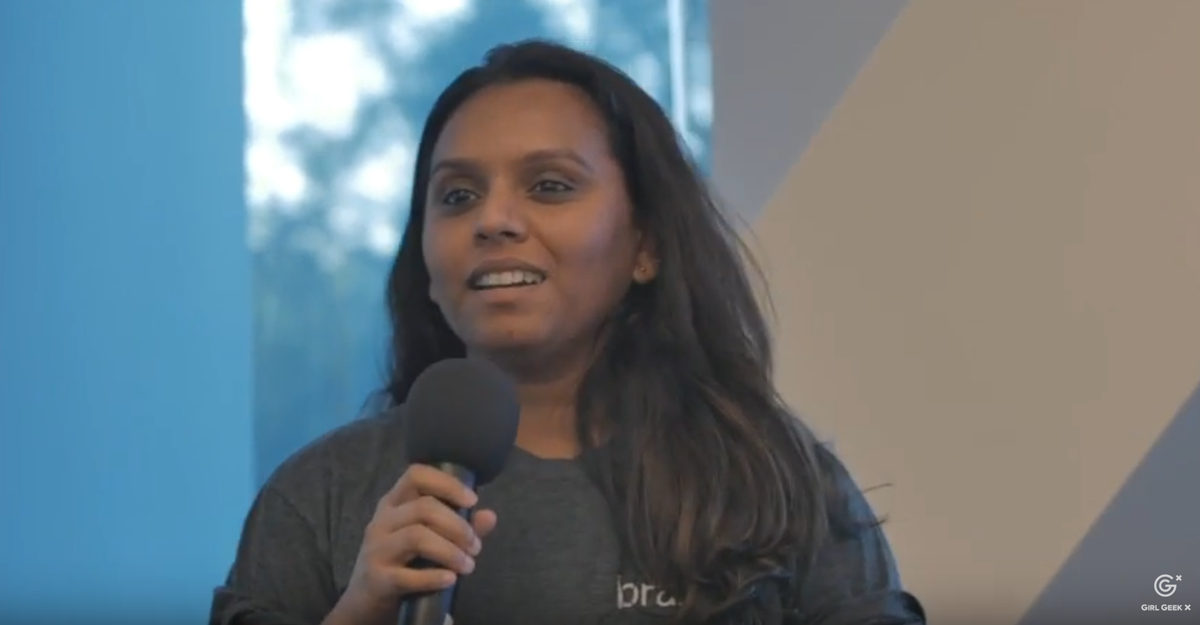
Senior Software Engineer Deepikaa Subramaniam speaking at Branch Girl Geek Dinner.
Deepikaa Subramaniam: Thank you, Zeesha. It’s really weird to use a mic, but hello, everyone. Welcome to Branch. It’s really amazing to see so many women from the tech space gathered here today. I’m Deepikaa. I’m a senior engineer in the product backend team at Branch. Today, I’m going to use my time to actually give a higher level overview of what the product backend team at Branch does, the components we manage, and also, a little bit about the technologies that we actually use in the backend team.
Deepikaa Subramaniam: Branch, on an average, actually, any given day it gets, it receives about seven billion events. When I talk about events, it ranges from anything like a Branch link click or an in-app activity, an app that has partnered to use Branch SDK, so when the app gets installed through the App Store or when the app gets opened or any purchase activity that happens within the app, the partners uses our SDK to send an event to Branch.
Deepikaa Subramaniam: It’s very critical to handle these events real-time because apart from deep linking, Branch is into mobile attribution, so we have to … When we see a conversion event like an install or an open, we have to determine at that point if the user has decided to actually install the app or purchase a particular product in the app by clicking on an ad.
Deepikaa Subramaniam: The product backend team is actually responsible for this entire attribution flow. As you can see, when an event … Let’s say an install event from the App Store comes into our backend service. It immediately gets inserted into our Kafka topic.
Deepikaa Subramaniam: Kafka’s actually a messaging broker. It consists of producers and consumers, so the producers … It has multiple event topics, which has producers and consumers feeding into the topic. Servers can actually feed the event into a … become a producer and insert an event into a particular event topic.
Deepikaa Subramaniam: We can have multiple consumers actually feeding on the topic, so they receive events from the particular topic. Our event processor does a lot of the backend, has a lot of the backend logic. What the event processor does is it actually listens on one of the event topics. It consumes the event, and then, it calls on to all these attribution networks, so Facebook, Google.
Deepikaa Subramaniam: These are all self-attributing networks, so if a partner has integrated with Facebook or Google as their ad network, and when we see and install event, what we do at that point is we call out to Facebook or Google and see and ask them, “Hey, did you see a particular click associated with this user for this particular app?”
Deepikaa Subramaniam: If we get attribution information at that point, we add it to the event. We call it like decorating the event, so we actually add the attribution details to the event. What happens if the partner does not have any of these self-attributing networks integrated, so what we have is a user store.
Deepikaa Subramaniam: For every user, we aggregate based on the app the last clicks that they’ve seen, and all these attribution information gets appended for the user. When a conversion event like install, open, or purchase comes in, we query this user store. The user store is actually … The backend is Aerospike. Aerospike is a NoSQL database. We query our user store to see if there was any event that has happened that we can actually use to decorate this conversion event.
Deepikaa Subramaniam: Once we find a winner from all these attributed networks, then we actually publish the event to downstream to again to Kafka topics. Why we publish these events to other Kafka topics is we have a lot of internal applications that actually consumes data from these Kafka topics. They consume the data, and they run through a lot of analysis. They power our dashboard, and also, we have a service called Webhooks, which the partner actually …
Deepikaa Subramaniam: Webhook is nothing but a partner-hosted API endpoint that they provide to Branch. Branch, when it sees an event, it immediately fires a webhook saying, “Hey, I saw an event. I saw a user interacting with your app, and this is the revenue or this is the impression or ad that they viewed or to do this particular activity.”
Deepikaa Subramaniam: This is kind of our attribution flow on a very higher level. I joined Branch actually four months back. Before Branch, I used to work for a company called Citrix. My background was, there, I used to work with C#, dotnet, and completely Microsoft all. Actually, when I was looking for a job change, most of my … Companies that have resume filtering with Java on it might assume even … didn’t even actually make it through because I refuse to add Java just for the sake of having a language in my resume. Luckily, I ended up in Branch.
Deepikaa Subramaniam: Branch is like one of the best things that happened to me. I’m saying this because a programming language should never be a barrier in our career to get into a company or into any position because it’s something that we can always pick up. The challenges that we face in learning a programming language is like the best kind of challenge we can have because we are learning, and we are growing.
Deepikaa Subramaniam: And I think that’s it. I would like to introduce Javeria. She’s a senior systems engineer at Branch, and next up.
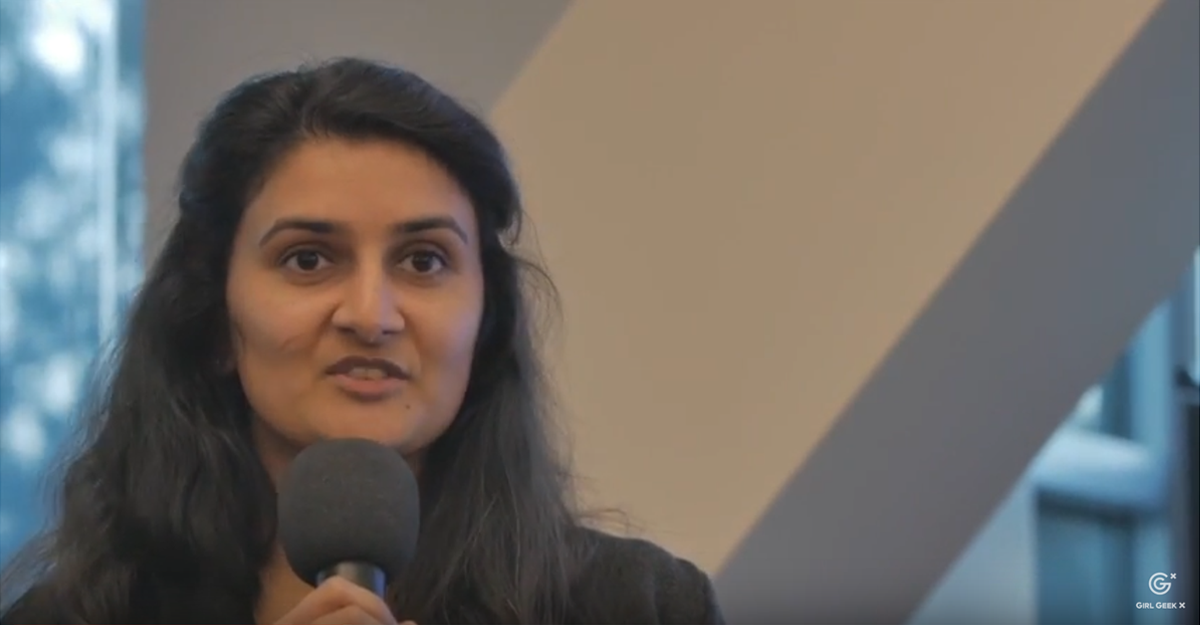
Senior System Engineer Javeria Khan speaking at Branch Girl Geek Dinner.
Javeria Khan: I’m Javeria, and I’m a senior system engineer here at Branch. By degree, I’m an electrical engineer, and I started off my career as a hardware engineer. I’m also a chip designer. I later moved to the software domain, and I’ve been now in the software and systems domain for the past five years. What’s cool about what I do here? Systems, in itself, is more about a breadth of knowledge over multiple engineering domains, and it is about depth at any one of them.
Javeria Khan: What that means is we get to work with everything from databases to networking to security to CI and many more. All of those cool products and features that Deepikaa and Zeesha’s teams create, we make sure that they get deployed to the CI and that they keep running smoothly through our monitoring infrastructure and that they have the resources that they need. My team, which is the infrastructure team is also the first line of defense for any infra issues, so we make sure we have the monitoring tools in place to detect and to be able to solve those problems easily.
Javeria Khan: What are the main focuses of my team? My team is, one of our main things we’re responsible for is making sure of our scalability and our reliability. We learned a lot of hard lessons here, so we host all of our infrastructure on a public cloud. Public clouds can have incidents, and they can have outages. Those affect us, as well, where we also go down for a few hours.
Javeria Khan: What we learned there was that we needed to make sure that our infrastructure was resilient enough to such kind of events, so we started a project to make sure that we were truly multi-region and which we redid everything we had done on the infrastructure side over the past two years in a new region. What that provided us with was we’re now able to failover traffic to any active region if any one of them is having an issue.
Javeria Khan: While doing that kind of project, which took about six months in the making, and other similar projects that we do on the infrastructure side, because we have to do a lot of provisioning, we have to put a lot of machines. This sort of racks up your cloud bill.
Javeria Khan: We have to also manage for costs and manageability, so that’s also one of our main goals. Besides that, one of the other things is we have to make sure that our data is fast and accessible. One of the metrics that we do hold ourselves accountable to is latency on the infrastructure side. These are just some cool numbers from our infrastructure side like Deepikaa mentioned earlier.
Javeria Khan: We do process seven billion requests a day. Branch has seen tremendous growth over the past three years where we’ve seen almost a 70% increase year by year. We’ve even seen up to 90% increase over two successive quarters over the last year. We also have three billion user sessions that can come in in a day, 100k requests.
Javeria Khan: Our data pipelines also see 10 terabytes of data per day, so with that tremendous kind of growth, what are the challenges that it brings in? The challenges on the infrastructure side are mainly to do with outgrowing your databases, making sure your apps scale well enough, also putting in a sensible auto scaling policies, and making sure that you’re appropriately provisioned for any kind of high volume traffic events.
Javeria Khan: Two such interesting events I’ll just mention here, we get a lot of these, but on the top left, HBO is one of our customers. This was the season premiere for a very famous, a very popular TV show with dragons and ice walls. When they had their season premiere, on the eve of that premiere, this is the kind of traffic we saw on infrastructure, but we were anticipating it, and we made sure that we were scaled appropriately for it already.
Javeria Khan: The bottom right one is from about two months ago during the FIFA World Cup, and we sort of saw spikes especially during goaling when somebody scored a goal for like some of the popular matches. It’s usually when people were sharing links or sharing links to the app, and people wanted to check scores. Such kinds of events, which are sort of relatable in the real world, we have to make sure that we cater for them. That’s what my team does, so that’s about it. I will now hand it over to Mada who is our amazing co-founder and also the head of marketing. Thank you.
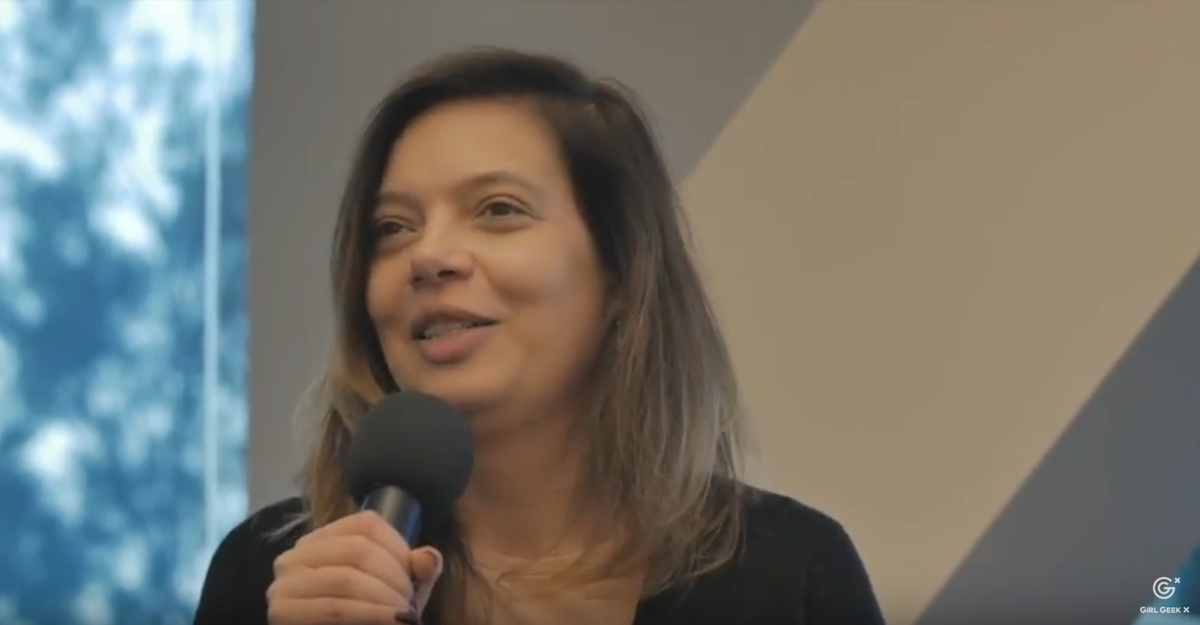
Co-Founder and Head of Marketing Mada Seghete speaking at Branch Girl Geek Dinner.
Mada Seghete: Thanks, Javeria. Okay. I don’t have slides. I have one slide. That’s me. The most important parts of my life was getting born, then graduating. I did the engineering, so I was also Computer Engineering, and I was training processor design, but I never did it. I went and worked as a software developer. It’s my first job out of college. Then, fast forward, I ended up starting an app with my co-founders here at Branch. We failed a lot. Then, we started Branch.
Mada Seghete: I think what I wanted to talk about was my journey into my current job, which is both being a founder but also doing marketing. I started being really good at math. When you’re really good at math, you’re kind of pushed towards doing engineering.
Mada Seghete: I remember, I felt this expectation that because I was good at math, that’s what I should do, and I really wanted to be creative. I would draw and paint and do things that were on the more creative side.
Mada Seghete: My mother, in a very Romanian way, would say, “No. You are not good at this. This sucks. You’re good at math. Just stick with math.” I was like, “Oh, God.” I went, and then when I got the scholarship to Cornell, and I remember I wanted to study architecture, and my mother was, “No. You can’t do architecture. You’re good at math. You have to do engineering. You have to the hardest engineering possible,” so I did it. Although she was in Romania, she still had a big influence on me.
Mada Seghete: I started Computer Engineering. I minor in CS, but I did take animation courses, and I actually animated a few movies in Maya, and 3D Studio Max, which is really cool. That was kind of when I started realizing that I really loved doing that more than I loved doing engineering.
Mada Seghete: Then, the story after that was very interesting. I worked in engineering, and then I had an issue with my visa, which meant I had to go to school. After school, I would explore something new, so I explored being a consultant and learning the business side of things.
Mada Seghete: I realized that I hated being a consultant. I was very good. I was actually at the top of my class, but I kind of realized that I love doing things, not telling other people what to do, and sometimes, they would never actually do it. As a strategy consultant, you don’t really do that much.
Mada Seghete: Then, I really wanted to do marketing. There was a practicing in Deloitte that did marketing, but they didn’t want to take me because I always got assigned to the technical projects. I then got the job. A startup came up to me and wanted to hire me, and because I had business experience, they put me in the business development and product because again, I was more technical. I ended up doing that for a while. I learned about being in a company and being in a startup. I decided I want to start my own.
Mada Seghete: Then, when we started working together, it was like, okay, my own company, I can do what I want. I want to do design, and I want to do marketing, so I started doing that from the very early days. I designed our app and did all the marketing for it. Then, when Branch came along, and Branch came from all the failures that we had as app developers, we decided to build Branch to solve all the problems that we had. That’s when we basically started Branch, and I started doing marketing.
Mada Seghete: I think the moral of the story is sometimes, you can be very good at certain things, but they’re not necessary … I actually think that at the end of the day, I’m a much better marketer than I was a software developer because I love it so much. I love promoting things. Marketing is all about numbers. I love numbers, but I can be a lot more creative. It just, it was an interesting journey. I run marketing at Branch, but I don’t have as much experience as probably other people of my age who lead marketing teams because I’ve only had the experiences in product and engineering.
Mada Seghete: The moral of the story is that you can start again. I’ve started again many times, and I was able to get to a point where I do something that I’m good at and I love. Don’t settle, I guess, to doing what you are good at. Try to also go for something that you’re good at but you also love, and believe in yourself.
Mada Seghete: I think the story that Zeesha said earlier … I would still remember the moment when I decided I was going to start my own company. I was at Stanford. I actually went twice. Every time my visa got denied, I went back to school. The first time after my interim began and I went and did the MS&E program, I was part of design school.
Mada Seghete: I was working with all the startups, and I was … This professor who’s also an investor, Michael Dearing, and I was helping him take stuff to his car one night after class. I remember telling him how much I loved working with these startups but that I would never start a company myself because I don’t think I could do it. I mean, who am I to start a company?
Mada Seghete: He stopped, and he like dropped what he had, and he looked at me and he said, “What do you mean, Mada? If you’re not going to do it, who do you think will? Of course, you can start a company.” I was like, “What? Oh, my God. I never thought about that.” That was a moment that I’ll always remember, the moment where something shifted. Then, I just went and worked for a startup. I quit consulting, went and worked for a startup, but it all started in that moment. I think for all of you, all you have to achieve any of your dreams, is kind of what Zeesha said, all you need is to believe that you can do it and to have tenacity and keep going after it and not be … It’s okay to fail.
Mada Seghete: We failed three times before Branch. No one would give us money. No one would talk to us. They keep saying … We tried Fitbit for dogs, photo book printing app, and then a printing SDK. Our name is still Pawprint Labs on some. No one wanted to talk to us. Then, the same team then ended up raising money and building a company, but it’s okay. It’s okay to fail. Just try again, and you will succeed. I promise you.
Mada Seghete: Okay, that’s it. I got to introduce Ann.
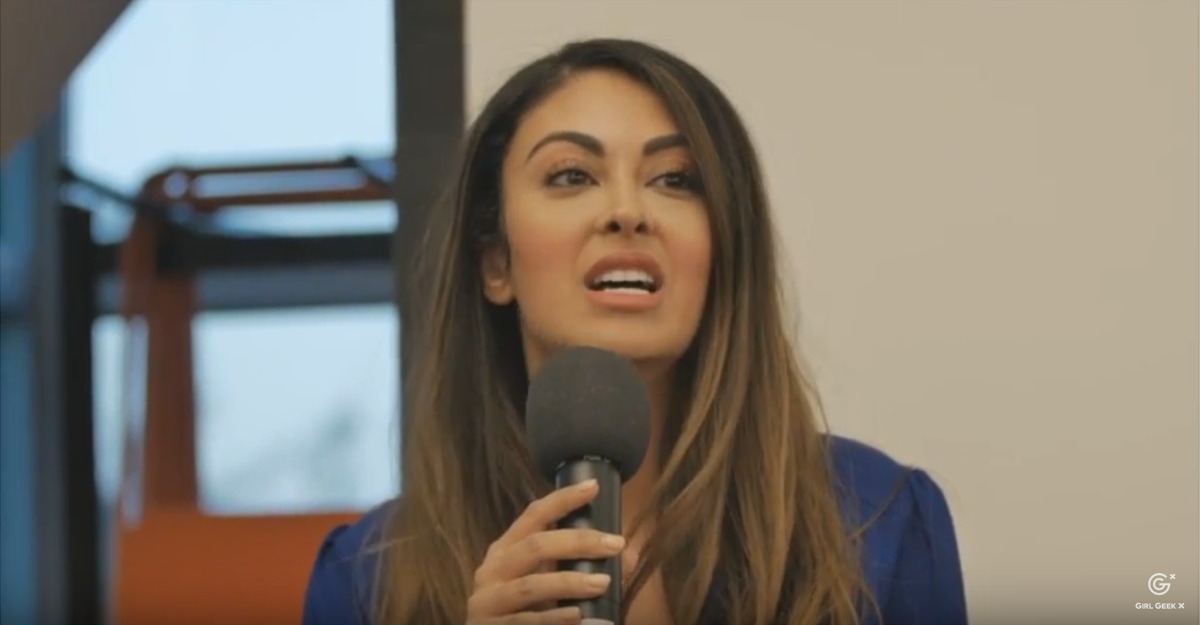
Strategic Partner Growth Ann Massoud speaking at Branch Girl Geek Dinner.
Ann Massoud: Hi, everyone. I’m Ann Massoud. I’m on the partner growth team at Branch, so you’ve heard from a lot of very technical folks here, but if you have any questions about the sales or business side, feel free to come find me after. We are hiring, but we’re going to do a slight intermission, so feel free to help yourselves with snacks in the kitchen or drinks or anything while we get everyone up here for a panel, so you guys can ask questions.
Ann Massoud: Okay, so we’ve heard some very inspirational stories from some really incredible women. Let’s give them all another round of applause. Perfect. All right, so we wanted to open the floor up for Q&A. We know that everyone’s come here with specific agendas, so we’d love for you to ask any of the women up here anything about their stories, their current roles, their career paths. Basically, anything’s on the floor, so go for it. Okay.
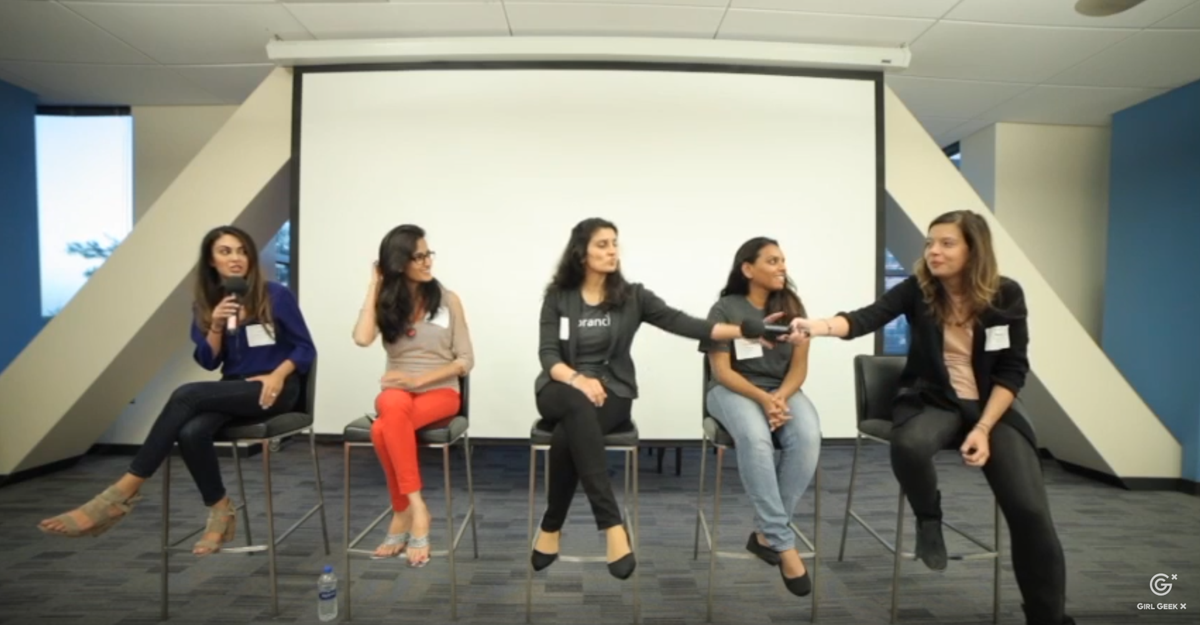
Branch girl geeks: Ann Massoud, Zeesha Currimbhoy. Javeria Khan, Deepikaa Subramaniam, and Mada Seghete answering audience questions at Branch Girl Geek Dinner.
Audience Member: What’s the percentage of women in engineering at Branch?
Ann Massoud: The question was, what’s the percentage of women in engineering at Branch?
Deepikaa Subramaniam: Monica probably knows the answer to that.
Monica Cuyong: About 20%.
Javeria Khan: 20%.
Ann Massoud: Perfect. Any other questions from the audience? Okay, over here.
Audience Member: You all kind of talked about your unique journeys. Can you talk about the most challenging leap you made or maybe the most challenging job that you took and why was it the most challenging when you took the change?
Ann Massoud: The question was, can you please talk about the most challenging leap that you took when you made this change for those who had to make different career path decisions?
Zeesha Currimbhoy: I guess you already heard my story on the most challenging thought, but I think for me, the most challenging one was when I moved from an engineer kind of in leadership role to actually running an entire organization with people who were once my peers, now being my direct reports, and people who had years and years more of experience than me, researchers, PhDs, definitely more skilled specialists who now reported into me, and I had to figure out how to provide them the growth opportunities and the mentorship while also planning out the entire roadmap of a strategic arm of the organization. That was by far, and with zero mentorship because I reported directly to the CEO, who had no time. It was definitely by far, the most challenging jump I’ve had to make in terms of different roles.
Zeesha Currimbhoy: I think that in the beginning, like the initial part of that journey was the most challenging because I couldn’t find my bearings. As an engineer, I still very much gravitated to an IC. I wanted to just go and code, and I wanted to fix things, and that was not my role anymore. I still very often found myself just wanting and itching to write the code and getting the credit for it because as a manager, you got to give the credit. It’s your team’s work. You’re responsible for growing the team and getting out of their way as quickly as possible.
Zeesha Currimbhoy: I think the first couple of months in my new role was the most challenging until I figured out how to get the mentorship I needed, and then make sure that I was very open and honest with what I could or could not provide the team. I could not directly tell a machine-learning engineer how to actually build their models because I didn’t have the experience myself. I couldn’t figure out, “Oh, you should use XGBoost versus something else,” and so I figured out how to get them the mentorship that they needed for them to be successful so that they could still respect me as their manager, and I could take care of the other things for them. That was the most challenging thing I had to deal with. Anyone else wants to add?
Javeria Khan: Sure. For me, it was when I switched from hardware into software. I had already been working for three years in hardware design, and I had also actually just gone and done a master’s with specialization in circuit design. When I switched over to software, because all the hardware tools at that point are basically for Windows, I had never really used Linux before, so I guess I started from my first RM and LS commands to actually doing programming for Linux. That was hard also because when you’re switching fields and you have people that are younger than you, less experienced but they’re farther along because they’ve been doing it before, but I guess technically, that was a challenge.
Deepikaa Subramaniam: For me, I think when I started off my career, I actually did an internship at a startup, which got converted as a full-time. As Zeesha mentioned, at that point, it was a great opportunity, but most of the time, I was so afraid because in a startup, it was a very small startup. Every opportunity that came your way was like you had to own the projects, you had … like from scratch design and interact with PMs.
Deepikaa Subramaniam: Since I was starting off my career in that particular company, everything was new, and most of the times, I approached the projects with a tremendous amount of fear, which was actually pretty much like as Zeesha mentioned during her talk, it was like setting myself up for failure, but I had a really great CEO and CTO who encouraged me a lot. They made me take up … They voluntarily made me take up a lot of projects, and that’s where I learned how to interact with PMs, how to own, how to design something from scratch.
Deepikaa Subramaniam: Also, it’s not just designing, right, like as a developer. You have to be responsible for what you do, and also even after you push the project, you have to be responsible for any issues that comes along extra [inaudible]. That was very challenging, but that was the most I learned in my career. I think it’s helped a lot.
Mada Seghete: I think for me, I was similar to Zeesha. When I had to transition from being just an IC at Branch and doing … I was doing all the marketing to hiring a team and learning how to manage people. I didn’t have any mentorship either. I just remember the first person I hired didn’t work out, and it was one of the hardest things I have to do to let the person go after … I think it was very fast. After like three weeks, it was very obvious. I realized that I didn’t know how to hire. I didn’t know what the team needed and kind of figuring that out, and then figuring out in time how to scale the team was probably the hardest thing learning. I guess, that transition to becoming a manager especially in a very high growth business like Branch was at the time.
Ann Massoud: Any other questions from the audience? Oh, perfect, right in the front.
Audience Member: I just started my own company, and one of the challenges.
Ann Massoud: Congratulations.
Audience Member: One of the challenges is mentorship. Zeesha and Mada, you both mentioned being in positions where you didn’t really have anybody to mentor you once you are at the top, so could you tell me a little bit more of where you ended up seeking mentorship when it wasn’t directly above you or anybody who was immediately available to you, and how that works out in terms of building your leadership skills?
Mada Seghete: I can start. There’s this great website called Female Founder Mentor Hours started by one of my friends. They have, I think about 300 women founders at all different stages who we all do at least one hour or two of mentorship a month, so I highly recommend trying that as one. Then, the other one, I think I really looked for mentors, I realized I needed mentorship in being a marketing leader, so I actually went my board, and I admitted that I needed help. They introduced me to a few CMOs of companies that were way further along than Branch.
Mada Seghete: One of them, Megan from MongoDB, is now one of my mentors. I really do run to her. Now, there’s some issue. The board wants me to show some new numbers, and I went. I just had a call with her for 15 minutes. I had her mentor me, but I actually had her come and talk to the whole team a few times and give advice in how they do things. They’re already IPO. They’re a lot further along than we are. I realized that I needed help, and I went asking for it, if that makes sense.
Ann Massoud: Awesome. Over here, question? Yep.
Audience Member: I have a question for Mada. How important is it to have a group of like-minded people along to create a startup and to try out ideas? If you were going to do it alone, can you do it on your own, or is it important to have like-minded people?
Mada Seghete: You can. I have founders, friends. The question is, how important is it to have like-minded group of women or either founders around you to start a company? I personally don’t think I could have done it alone. I think it depends on who you are as a person. I don’t think I could have gone through the hard times on my own. I mean, it was really hard. I wanted to quit sometimes, and I think having my co-founders there to keep me going, I would have never been able to build Branch on my own. I do have other friends who are founders and solo female founders who are successful. I do really think it depends on the business, on the type of business and the type of personality that you have. It’s definitely not impossible. It’s way harder.
Mada Seghete: I invested in and I mentor one of my friends who’s doing a company by herself. Man, she messages me a lot, because, I think, she’s by herself. She doesn’t know where to get advice from, and she has a group of other female founders. It’s not just me. I think she pesters all of us to ask for advice and support. I never needed that.
Mada Seghete: I think in the early days, we relied on each other, so if you do it on your own, make sure you have a very strong support network. If you can have co-founders, I think having at least one person that’s you’re other person … It’s so hard at the beginning when you keep failing, and when you get to our stage now, it’s different. We have amazing other leaders in the organization. We can rely on other people, but in those first two years when it was just us failing over and over again, I would have quit, I think, if it was just me.
Ann Massoud: Karen, I think you had a question.
Karen: [This is] mostly for the engineers in the group — how do you balance company objectives, getting new features out, building stuff with the tech background that you have now versus learning new things because sometimes, it feels like it’s two full-time jobs, staying on top of what’s new, and then expanding your skillset versus actually doing stuff with what you already know?
Ann Massoud: To repeat the question, it’s how do you manage learning new things and still doing your day-to-day?
Deepikaa Subramaniam: I completely agree. Actually, this has been a constant challenge in my career as well. One of the things throughout my career I’ve tried to actually build is, it’s very hard to be motivated to learn something that’s outside your work unless you’re building your own company and constantly put in time to build that and learn through that project, right? What I try to do is I try to find, like if you can build a good rapport with the product managers in your company and try to figure out like something that’s not very high priority project that’s very interesting, and at the same time, it’s not something that aligns with your day-to-day work.
Deepikaa Subramaniam: Here at Branch, when I presented one of the major components that I work with is the Aerospike store and how the services interact with it, but I’m super interested in learning about Kafka and Spark consumers and Apaches, how they all interact and work together. I’m constantly trying to find time and maybe do a POC like figure out if there’s some small project that you can work on, which involves a technology that we don’t know and probably build our expertise on it.
Zeesha Currimbhoy: You want to go?
Javeria Khan: Sure. Personally, I think I’ve gotten better about this over time. I always have a list of things that I want to look at or read up about. What I do is I try to set aside half an hour every day to sort of go through articles or things that I’ve sort of pinned aside. Also, when it’s not too crazy, and it’s not supposed to be always crazy … You have days where you don’t have that much work to do. You can get more reading in. You can get more exploring stuff in. I think it’s up to you to set those goals and to sort of make lists for yourself and know when to go through them.
Zeesha Currimbhoy: My answer is more a managerial standpoint answer. A, know the technology and know the space. Even if you want to learn something, I would suggest everyone set aside, like Javeria said, set aside some time for yourself. It can be one in the morning when you’re having tea or coffee and just chilling at home. Set aside some time to read through articles that you care about that you’re interested in. Get to know the space. Get to know what you want to do.
Zeesha Currimbhoy: Second, be very open and have a conversation with your manager. It’s very hard to do it yourself. It’s very hard to try to make time for this for yourself. You’ll never find the time. To be honest, you’ll just never because there’s always other things to do. There are always business priorities. Be open and have a conversation with your manager if you’re working about things that you want to learn, areas that you want to start exploring because chances are that there will be something that you will either get to learn by maybe spending some time in another team or maybe there will be a new project that comes along that will need the application in there. I think that the best way to actually get that time is to make your goals and objectives clear.
Zeesha Currimbhoy: Another asset is if you’re a part of a company like Branch where we’re constantly … the way we build technology is we don’t just take the latest, greatest, and then go and play and tinker around with it. We’re trying to build a sustainable company, and so business objectives matter a lot, but we always are aware of the trends in the industry and whenever we’re faced with a difficulty like Kafka’s falling over, we say, “Okay, what else is around? Let’s go investigate. Is there something else that we can use? Let’s play around with it and see if it’s going to solve our problem.” We always evaluate technology in the context of a problem that it’s going to solve, but that’s always an opportunity for something new to be introduced into the stack.
Ann Massoud: Any other questions from the audience? Perfect. Right in the front.
Audience Member: I actually had a question a little bit more about your origin story. You talked about you’ve done a bunch of startups before this, but how did you and your co-founders actually get the idea to do Branch? What was that process like?
Mada Seghete: There’s a story we tell, and then there’s the real story.
Audience Member: Real story.
Mada Seghete: The story we tell is that we started building Branch for our own app, and then, we ended that we saw there was much bigger. The true story is really that we got to a point where we realized that printing wasn’t going to be a big thing, and we had tried. I think Alex, our CEO, is very good at seeing the future in some ways. He was always the first one who would notice that, okay, this is not going to work.
Mada Seghete: We got to a point where I think we were about to graduate from business school, the app was still live. We were selling photo books, but it wasn’t doing that well. Then, we had tried his printing SDK. When we were trying to sell the printing SDK, people would say, “We don’t care about monetizing our app. We care about growth.”
Mada Seghete: One Sunday, Alex was like, “Who has time to brainstorm an idea?” It’s like this printing thing is not working, so I went to his place, and we sat in his kitchen. We started thinking about, what was the biggest problem that we had and what was the one thing that if we solved would have made our lives better?
Mada Seghete: The previous months, I was trying to build for the app. I was trying to build a referral program and a sharing program. If I invite a friend, they should get a free book, and I would get a free book. Then, if I share, if I start a book and I share it to the friend, and they installed the app, they should be taken to the book that I shared with them and then add more photos and then send to print.
Mada Seghete: It was impossible. To me, it was crazy. I kept bugging Alex and being like, “No, there must be a way.” I would go to Stack Overflow myself and be like, “Oh, Alex maybe doesn’t have time for this. I’ll try to figure out the technical side of how to do this.” Same with ads, on Facebook. I would run ads, and I would want to know when someone installed the app which ad that came from. I was crazy. I would actually go to friends that work at Facebook, and I was like, “It’s an ID. Can you send me this ID?” They’re like, “No, we don’t do that.”
Mada Seghete: When we were sitting at the table, I came, I said, “How about this referral thing?” and then he’s like, “Yeah, you’re right. That could be a thing. Let’s figure out if other people have the problem.” We actually called four people that worked at other companies, one that worked at Van Gogh, which is the first app that used Branch, one that worked at GoGoBuy, then one that worked at Zynga, and one another classmate that worked another gaming app. We asked them all, “Hey, was this a problem? Did we just not figure it out because we didn’t know?” and they’re like, “No, this is why …” The guy from Zynga was like, “That’s why Zynga didn’t grow, because referrals were so well on Facebook, and you could just invite a friend and get five gems when they were into the app, but you couldn’t do that with apps because you couldn’t pass any parameters to install.”
Mada Seghete: At that time, I think Alex was like, “We’re onto something.” Then, I think as we started building this, he realized that there was more than just referrals and sharing.
Mada Seghete: These links could be what powers … this idea of deferred deep linking could be used in all other channels, and that’s how it started. It really was from a problem that we faced. I wouldn’t say that we fully started to build it for ourselves. We were thinking. I mean, he had investigated a way to build it, to solve the problem that I kept bringing to him. I was like, I was basically reading growth and trying to grow the app.
Mada Seghete: We did decide that we needed something new. We realized that the business we were in wasn’t going that well and that we needed a new idea, so we probably would have never found Branch if we weren’t like working in the app space for like a year and a half beforehand.
Audience Member: That’s cool.
Ann Massoud: Any other questions from the audience? We have two. Go for it.
Audience Member: I have a comment. If you’re a woman and a mom and you feel a little bit isolated, there’s a fabulous Facebook group called Moms in Technology, and they’re very supportive. I really recommend it if you’re a mom in technology.
Zeesha Currimbhoy: Yeah, it’s great.
Ann Massoud: Thank you for that.
Mada Seghete: Zeesha also wrote a blog post about being the first mom on Branch that I highly recommend on Medium.
Ann Massoud: You had a question? The one on the side. Yeah. Yeah.
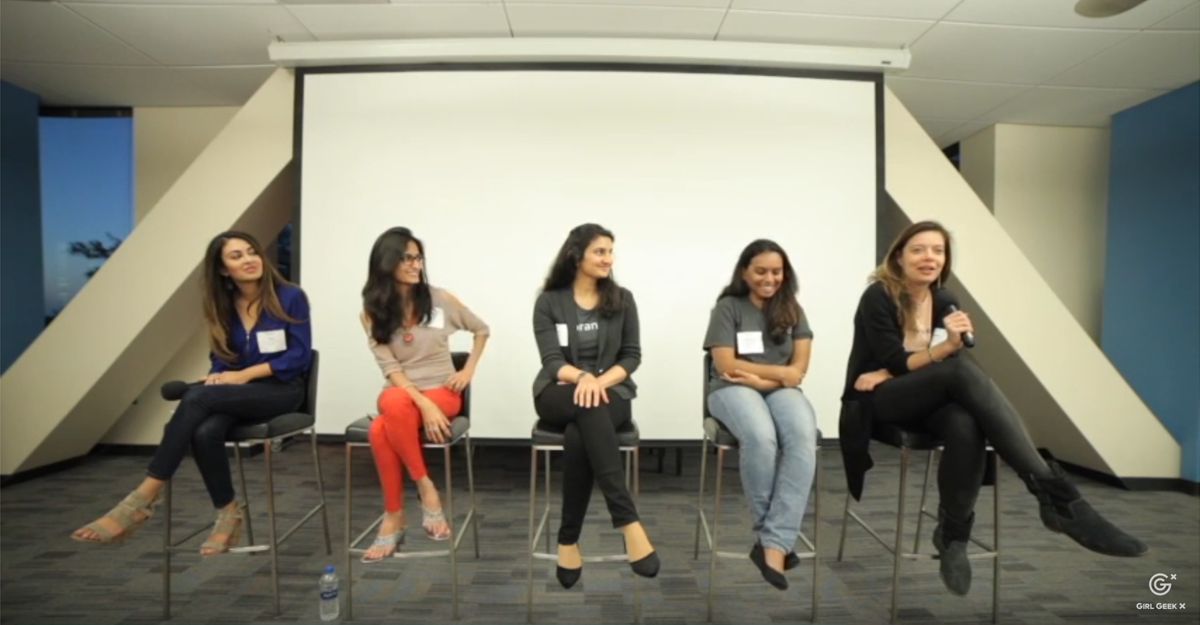
Branch girl geeks: Ann Massoud, Zeesha Currimbhoy. Javeria Khan, Deepikaa Subramaniam, and Mada Seghete speaking at Branch Girl Geek Dinner.
Audience Member: I wasn’t sure if you were [inaudible]. Thank you for sharing all your stories today. It was really inspiring. My question is for Mada. You alluded to advanced degrees that you had to pursue, but I’m just wondering if … The rhetoric that I’m surrounded with today is very much that if there’s something that you want to learn, if there’s someplace that you want to be, you learn the skills, you get there, and you don’t really need a degree to do that, but I was just wondering since you’ve had multiple experiences of advanced degrees, are there any tangible or intangible benefits to kind of going through that process and getting you to where you are today?
Mada Seghete: We would not be where we are today if we hadn’t gone to business school. It’s not because of the things we learned in business school — it’s because of everything else. I think you are … you go and you are surrounded by all these people, and it’s the same with my MS&E degree.
Mada Seghete: I was an engineer and going to MS&E changed me into being able to think more businesslike. I met different people. I think in business school, it was very much like the type of people that were there were very different. There was this idea that you could do anything, and I don’t think I’d learn … I mean, maybe I did probably learn from classes because most classes were a case study with an entrepreneur from there who came and talked about their failure, their successes. They kind of gave me this belief that I could do something.
Mada Seghete: I think all of us had very different stories. For me, I don’t think I had the belief that I could start something myself. I kind of believed it, but I also needed a team, and I found Alex and Mike. Alex came from doing semiconductors. I think he really learned how to be like a business leader. He had a mind shift change in a way. Mike came from Minnesota where he was just working for 3M as an engineer, and I don’t think he wanted to come to Silicon Valley. Alex and Mike didn’t really have a network. I had.
Mada Seghete: I was in BD, and I knew some people. A lot of the original deals came from me because I had the strongest network, but they didn’t have that. Going to business school helped them build that, and it also gave us this credibility when we went and raised money. It did open doors. When we’re doing the Fitbit for dogs, people took our email. I mean, most times, they didn’t give us a meeting, but they did like say, and sometimes, we did take a meeting, and they were like, “You guys are smart guys. Work on something else.” They did, and we’re like, “No.”
Mada Seghete: I mean, we only lasted like maybe three months, the Fitbit for dogs, but even if printing. We would get a lot of meetings because we had a really good app, and people will be like printing sucks. Get out of printing. We’re like, “No, we’re going to do it differently. We’re different,” and then eventually, they were right, but it does.
Mada Seghete: Business school gives you … I think an advanced degree gives you certain things, but you’re right. I mean, it’s not like a lot of the actual tangible things, we could have learned from books, we could have read, but I don’t think you get to meet the type of people you meet. You don’t get the environment, so there’s a lot of intangible. I don’t think we would have been where we are today. Maybe one day, we would have gotten there, but I think it accelerated our path.
Ann Massoud: On the left.
Audience Member: Thank you for sharing your stories. I was curious if you’ve ever been overlooked for a promotion or even just what you said for being a woman.
Ann Massoud: Question was if you’ve ever been overlooked for a promotion just for being a female.
Audience Member: That’s great if you haven’t.
Mada Seghete: I mean, I’m very aggressive. I’m like a little … If I feel I’m overlooked, I just go and fight for it like crazy. I mean, I think it’s possible. I don’t think so. I think I was very lucky, and also, I think my personality. I’m like very aggressive, but yeah, I think I was probably more discriminated around my career for being Romanian and having an accent than I probably … I probably felt more insecure about the fact that I was an immigrant than I felt for being a woman. People didn’t want to be my partner because I was a woman in Cornell because I think they thought I was dumb in computer engineering, but I think that’s probably the most I felt it. I don’t know if you guys have stories.
Javeria Khan: I don’t have a story, but I think the industry is better about it generally. I mean, this is maybe something that happened more frequently about 10 years ago, but in the past five, six years since I’ve been working, if you do what you you’re doing well, I don’t think there’s actually any sensible manager out there that would actually overlook you just for being a female. In most companies, Branch included, obviously, what they’re looking for is talent and what they’re looking for is good workers. Perhaps, I’ve been lucky to be having worked in such good companies that I never felt having experienced those kinds of things simply because of my gender, but I think maybe it’s not as common as we think it is.
Audience Member: One, I’m a hiring manager, and what I see is a lot of female engineers, they don’t ask for the salary, but male engineers are. Just as a general comment, if you have that experience, if you’re good enough for that job, make sure you know your value and you’re asking for the right salary.
Javeria Khan: I agree. We tend to be more shy and introvert than our male counterparts, but that’s something that can fix on our own.
Mada Seghete: I think that’s true. As a manager, and my team is pretty much half-half, men are more likely to ask. I mean, I give promotions even when people don’t ask, but usually, with the women on my team, they come from me versus in the past. I’ve definitely noticed a trend especially with a team that’s pretty half-half.
Deepikaa Subramaniam: Sometimes, I feel like when you’re a [inaudible] engineer, you don’t think about moving forward, progressing in your career. Title doesn’t … That was my attitude in my previous company. Well, how does our title matter? Actually, how do I put forth, like she mentioned, how do I put forth asking for more salary and stuff like that, but I agree with Javeria. That’s something that we should build on ourselves, build by ourselves. It’s not actually an issue with the people that we work with. It’s our issue. I think we should think about it more and fix, act on it.
Zeesha Currimbhoy: I think the main question that was being asked was, how do you know what to ask for? How do you know the amount to ask for? I think that the way is the first most important thing is to know your worth, is to always know there are several sites out there that’ll tell you what does a senior engineer make, or how much is someone going to make, but I also think that making sure that you’re trying to work at one of those good companies that’s fair.
Zeesha Currimbhoy: It’s harder to know which are the good companies that are fair, but one of the things that I encourage a lot of people that I mentor to do is to speak with enough people.
Zeesha Currimbhoy: When you go on the on-sites, speak with enough people, speak with the panel to make sure that you get a sense of what the culture of the company is as well. You should be able to sense that this is a company that I want to work to that respects individuals, that respect people. Through your questions, kind of try to get a sense of that.
Zeesha Currimbhoy: I think that the other thing is also, in an interview, when you’re interviewing, it’s fair to ask, what is the band that you have in mind for this position? That’s one way for you to ask upfront, which is before you disclose the number you want, is try to get a sense of what is the band that is being offered for that position.
Ann Massoud: I think a good way to vet companies is to look for companies that have diversity inclusion working groups, different employee resource groups, and that’s a great way to know if the company respects individuals like Zeesha had mentioned.
Audience Member: Can I just add a word? If you’re in product management, there is a Women in Product group. It’s global. It’s not just San Francisco Bay Area. People have seen demand from all over, from countries, Turkey, U.S., UK, everybody asking questions, mentoring, salary related, how they are switching from one job to the other, so it’s a great resource group. It’s on Facebook. You can join, and it’s very well structured through. The founders are also VCs, former product managers from Facebook and so on.
Audience Member: The other thing I wanted to add on the engineering side is there’s a group called Systers. It used to be very popular before when I was in engineering. It’s run by the Anita Borg Institute as well. It’s one of their original arms. It’s a community, again, a community thing run by women for women in engineering. It’s so old. I think it’s probably from the late ’90s. It’s still very active. It’s very simple mailing list. When I went from engineering to business school, I was struggling with that transition, and I posted, and I got a lot of help from the women. I would say, you have all the portals, but it never is enough. How much you need, you do your own research and that one on one is where you will get the confidence to actually negotiate as well. There are women out there who will do mock interviews, who will help you do mock salary negotiations because that’s where the rubber hits the road.
Ann Massoud: Perfect. This has been a very amazingly passionate crowd, so thank you very much. We only have time, unfortunately, for one more question, so hope it’s a good one. No pressure. Perfect.
Audience Member: This is sort of a different angle. It’s actually a follow-up question to the one I asked Mada, but I actually want to ask you, Ann, because you said you’re on the sales side.
Ann Massoud: Yes.
Audience Member: I was actually curious, like can you give us examples of who are the profile, who are your customers or partners that you go after, and then, what is the value prop? What is the key thing that makes them sign up for your service?
Ann Massoud: I’d need like an hour with you, but essentially, for the … The key customers that we go after is essentially anyone with an app. I’m on the more strategic enterprise side, so we’re going after apps that have very high MAU, so that’s monthly active users, so people that are constantly going to their app on a monthly basis are typically the people that I would personally target. In terms of our differentiators or why someone would work with us, essentially, we’re going to help them with their mobile growth, so being able to drive people into the app, give them a very seamless user experience, and then most importantly, being able to tell these enterprise companies who these people are, how they’re interacting with the brand, where they originated, how they continued to interact with these marketing channels, and then ultimately, what led them to convert.
Audience Member: Thanks, Ann.
Ann Massoud: No problem. All right, everyone. Well, thank you so much for coming again. We’re super happy to have you. Another round of applause. Again, if you have any questions for any of us, please feel free to come back and ask away. Branch is hiring, so we have tons of open reqs at branch.io/careers. If you have any specific functions that you’re interested in, I’m sure anyone up here would be happy to talk to you about them. Have a good night. Enjoy the rest of the snacks in the kitchen, and I think there’s some drinks left. Good night, everyone.
Mada Seghete: Thanks for coming.
Ann Massoud: Thank you.
Our mission-aligned Girl Geek X partners are hiring!
- See open jobs at Branch and check out open jobs at our trusted partner companies.
- Does your company want to sponsor a Girl Geek Dinner in 2021? Talk to us!


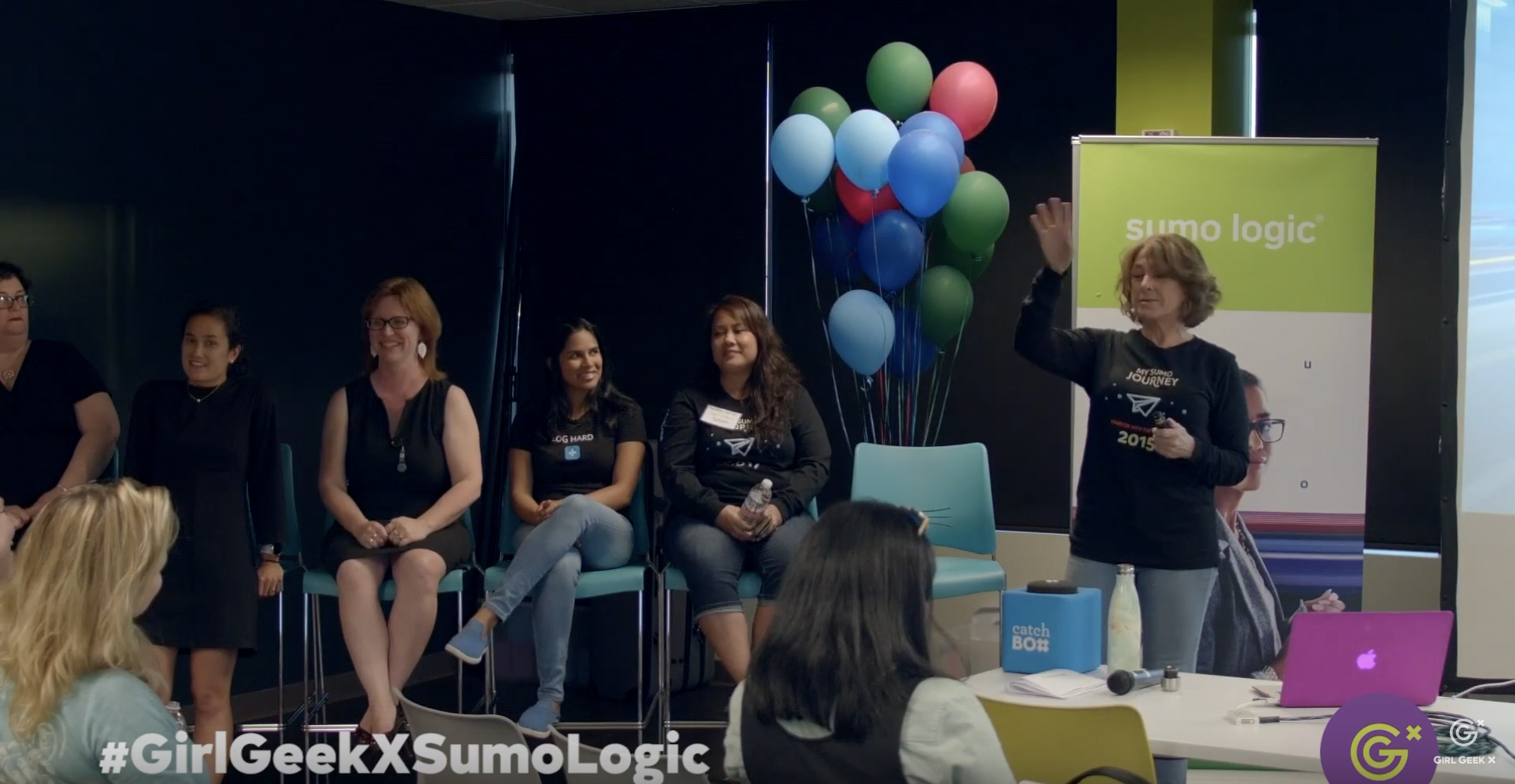
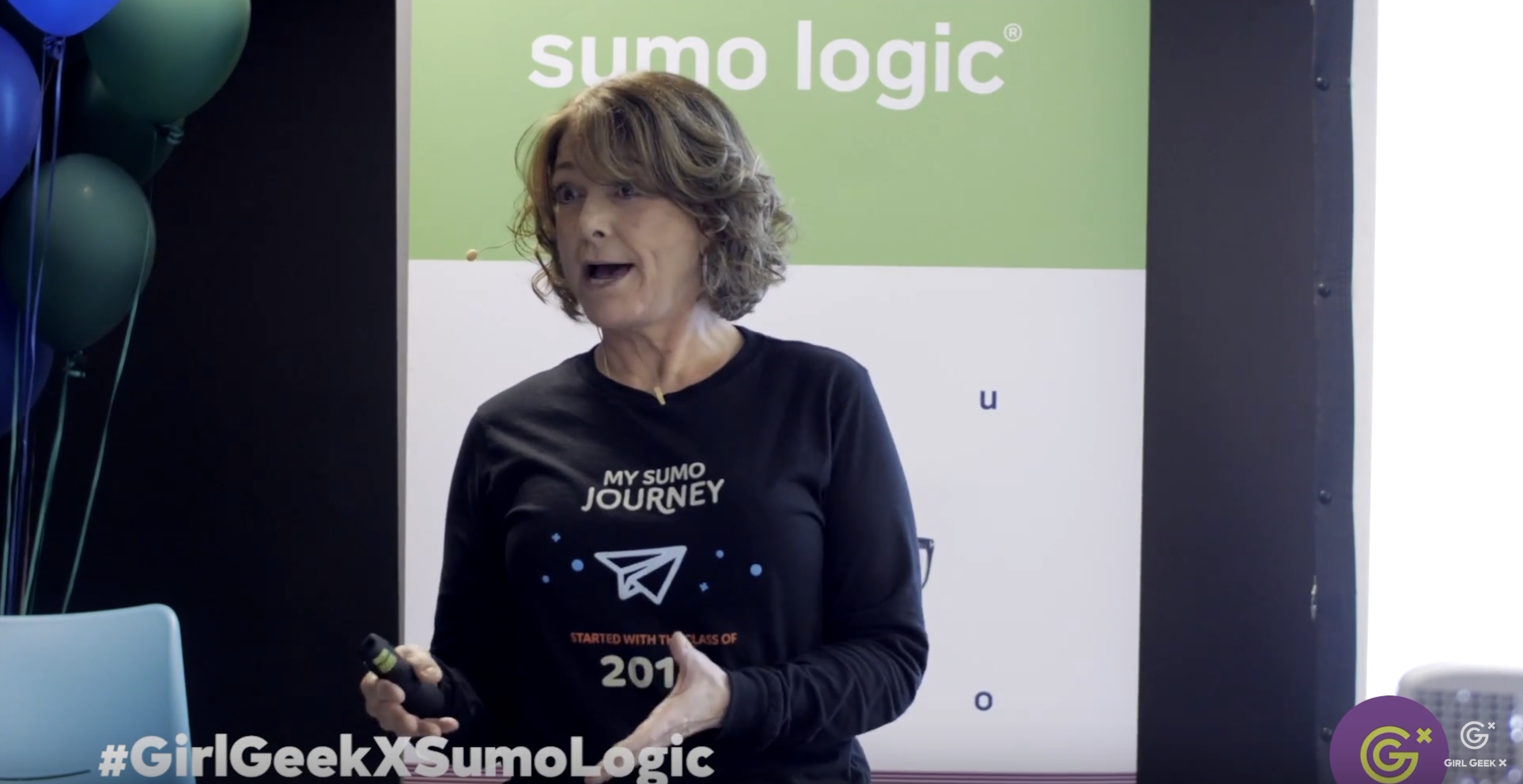
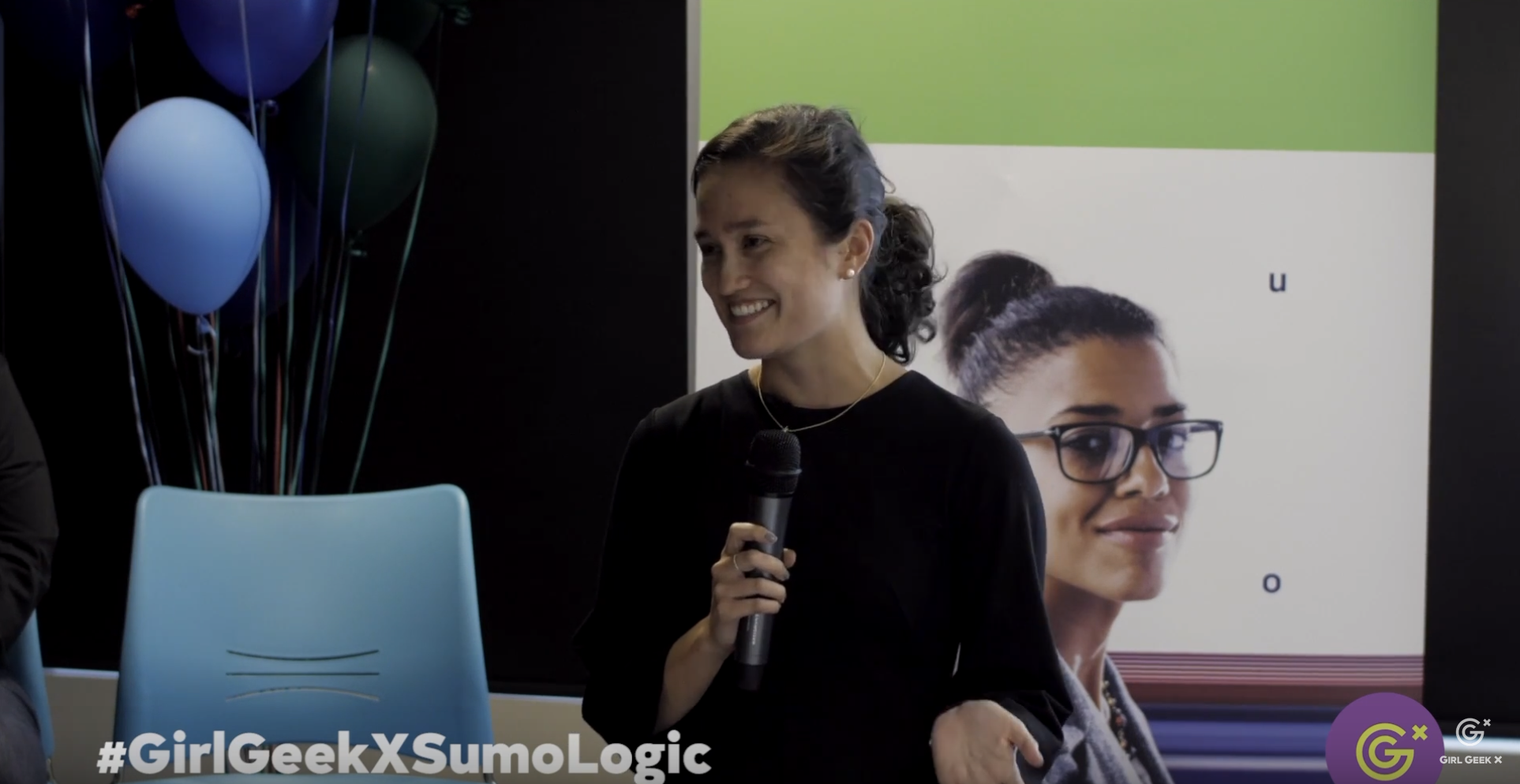

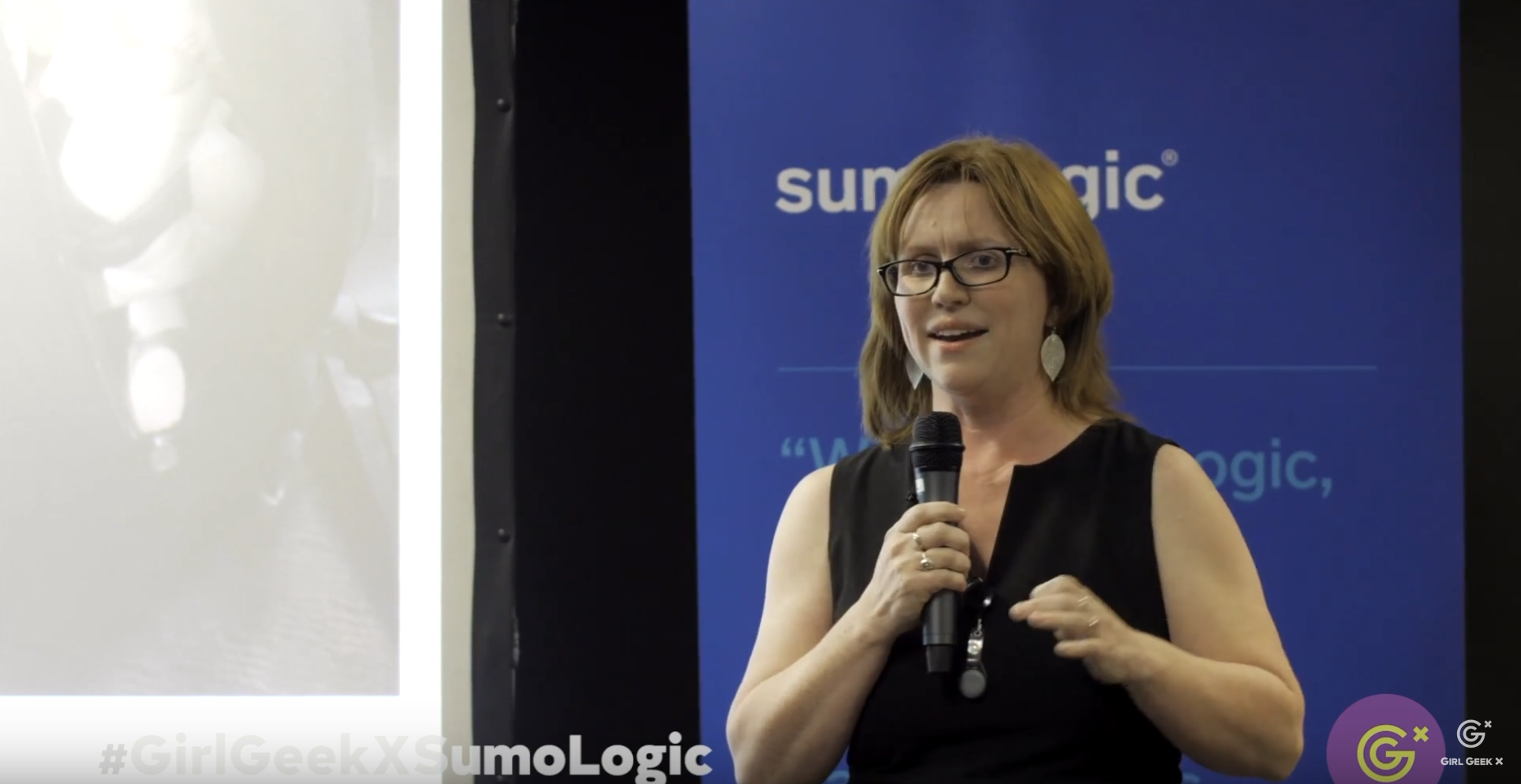
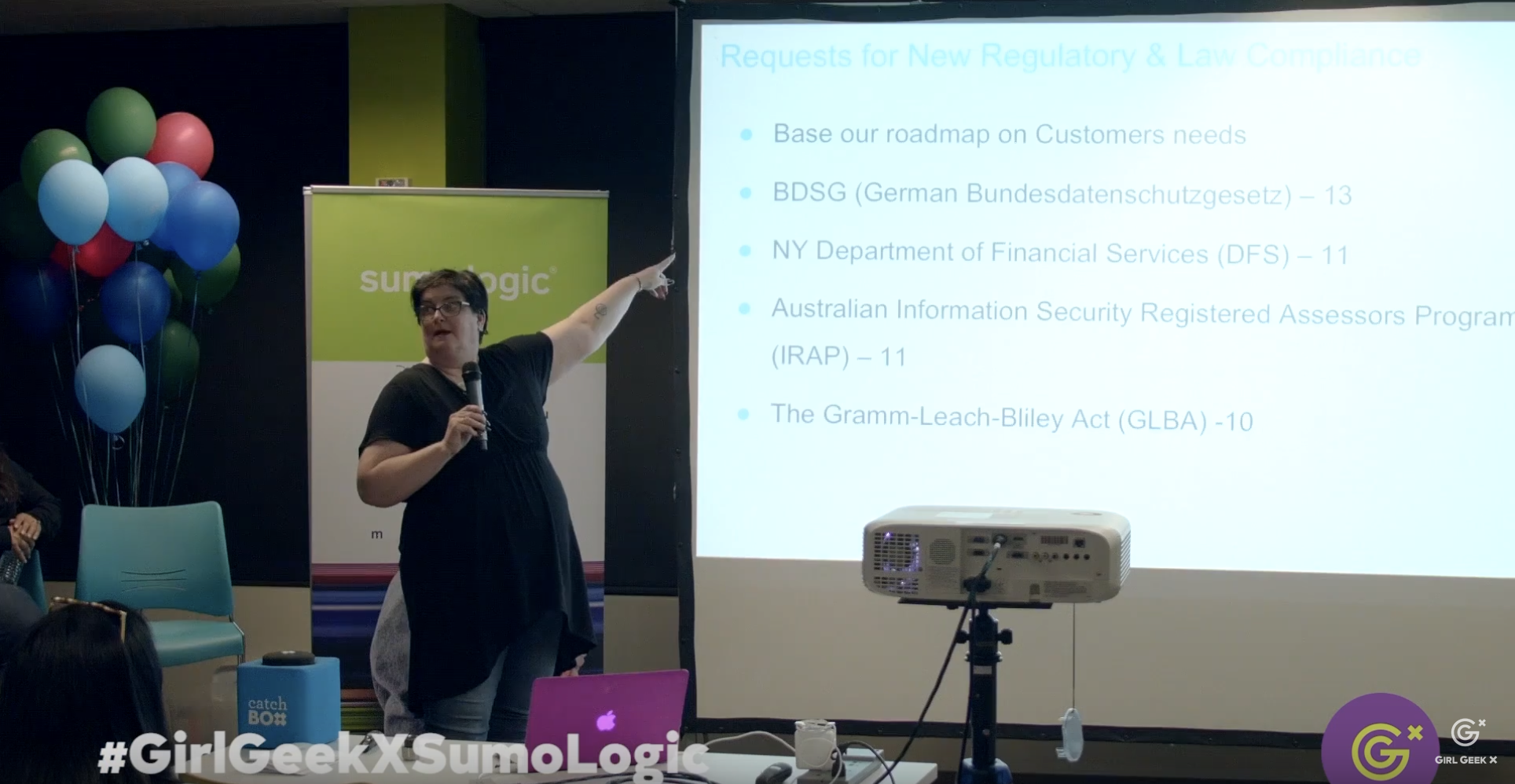
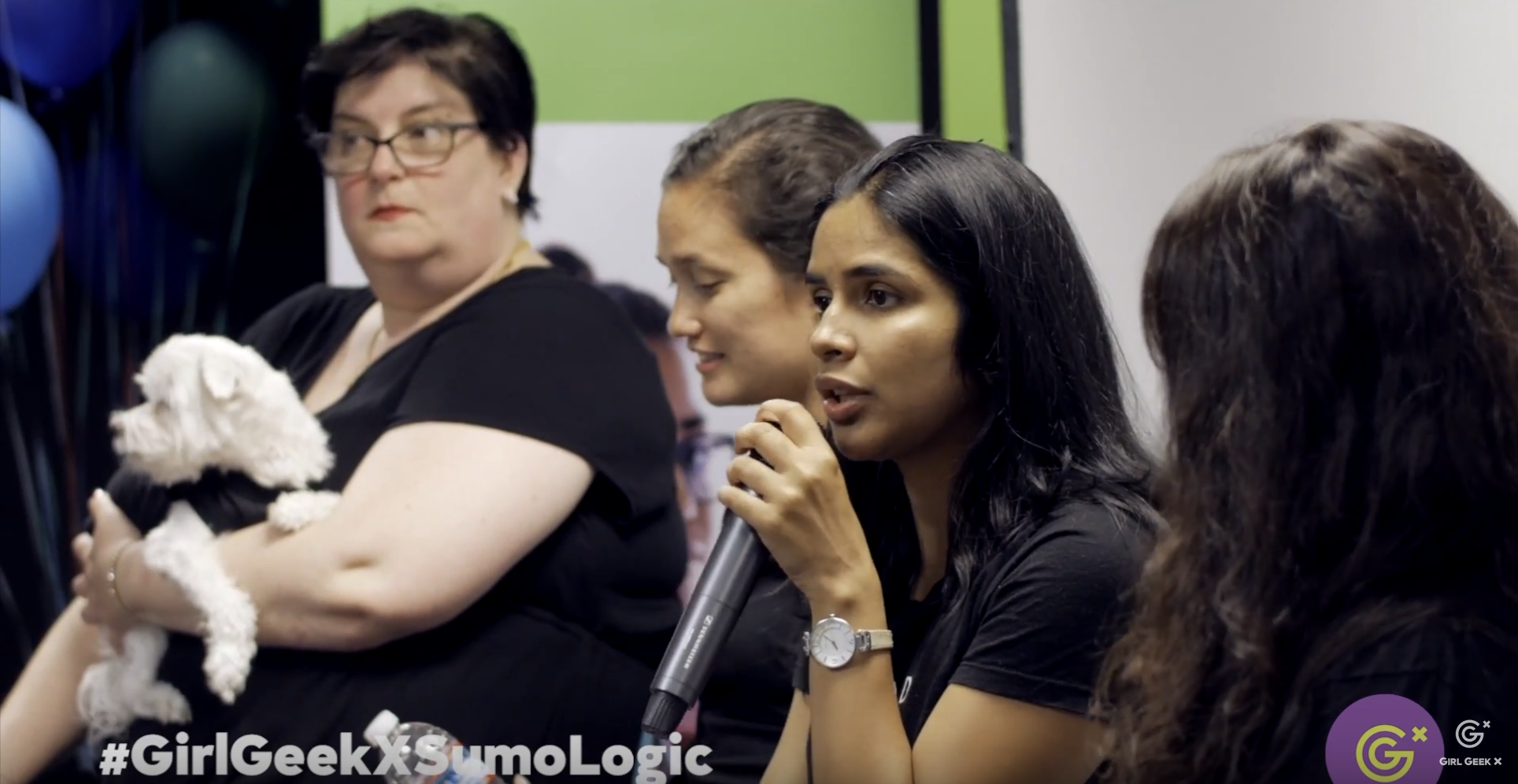
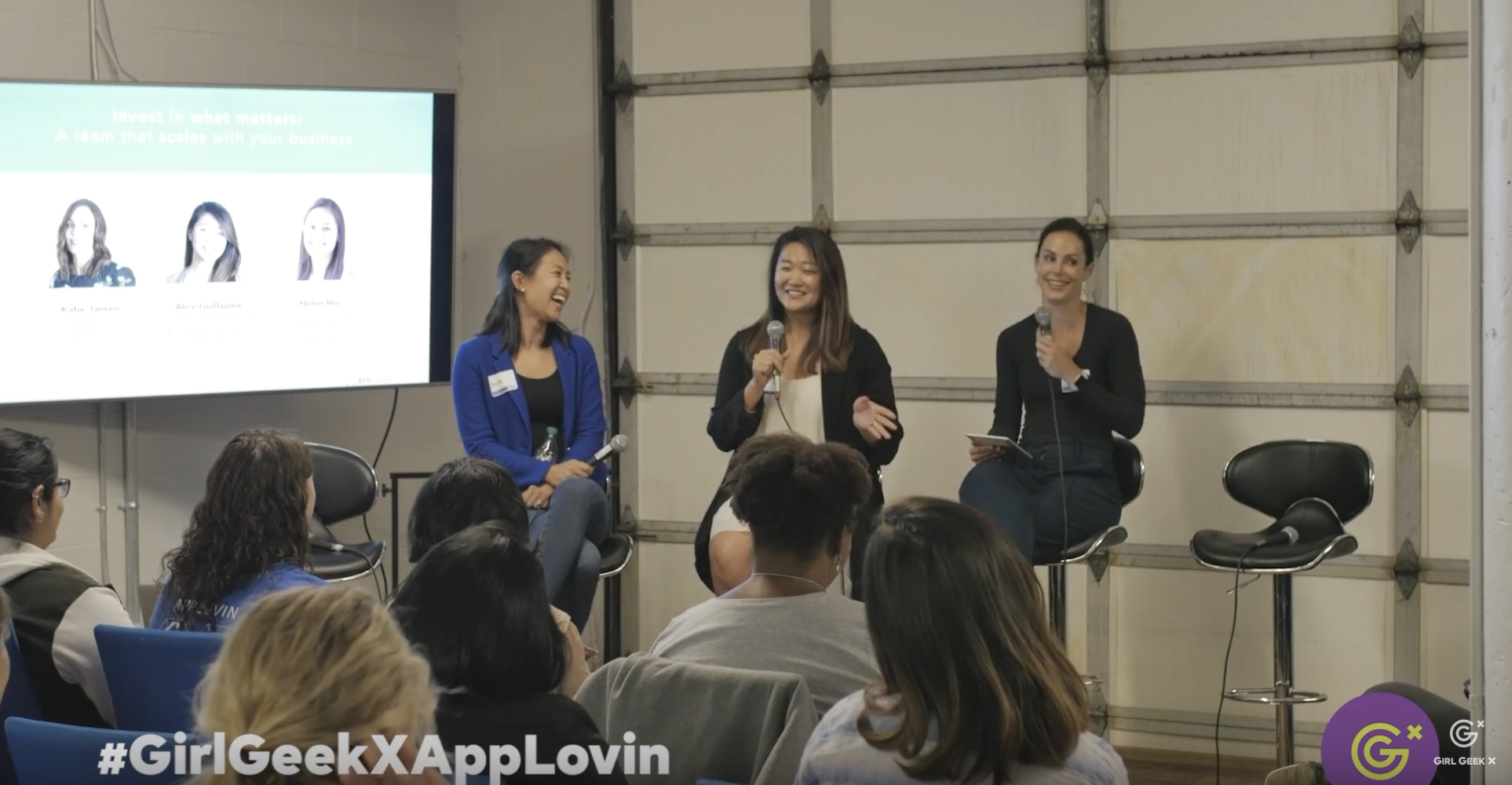
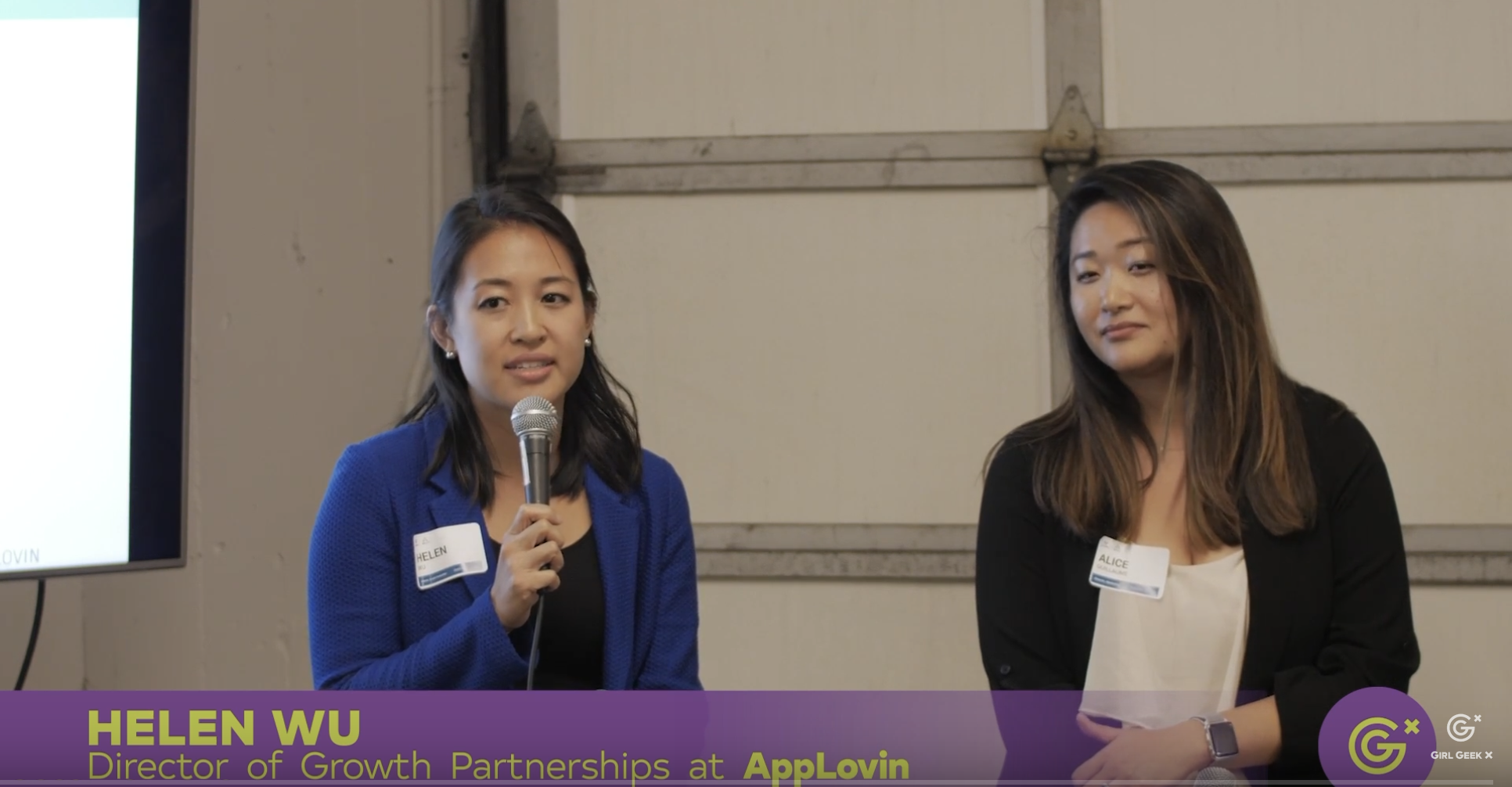
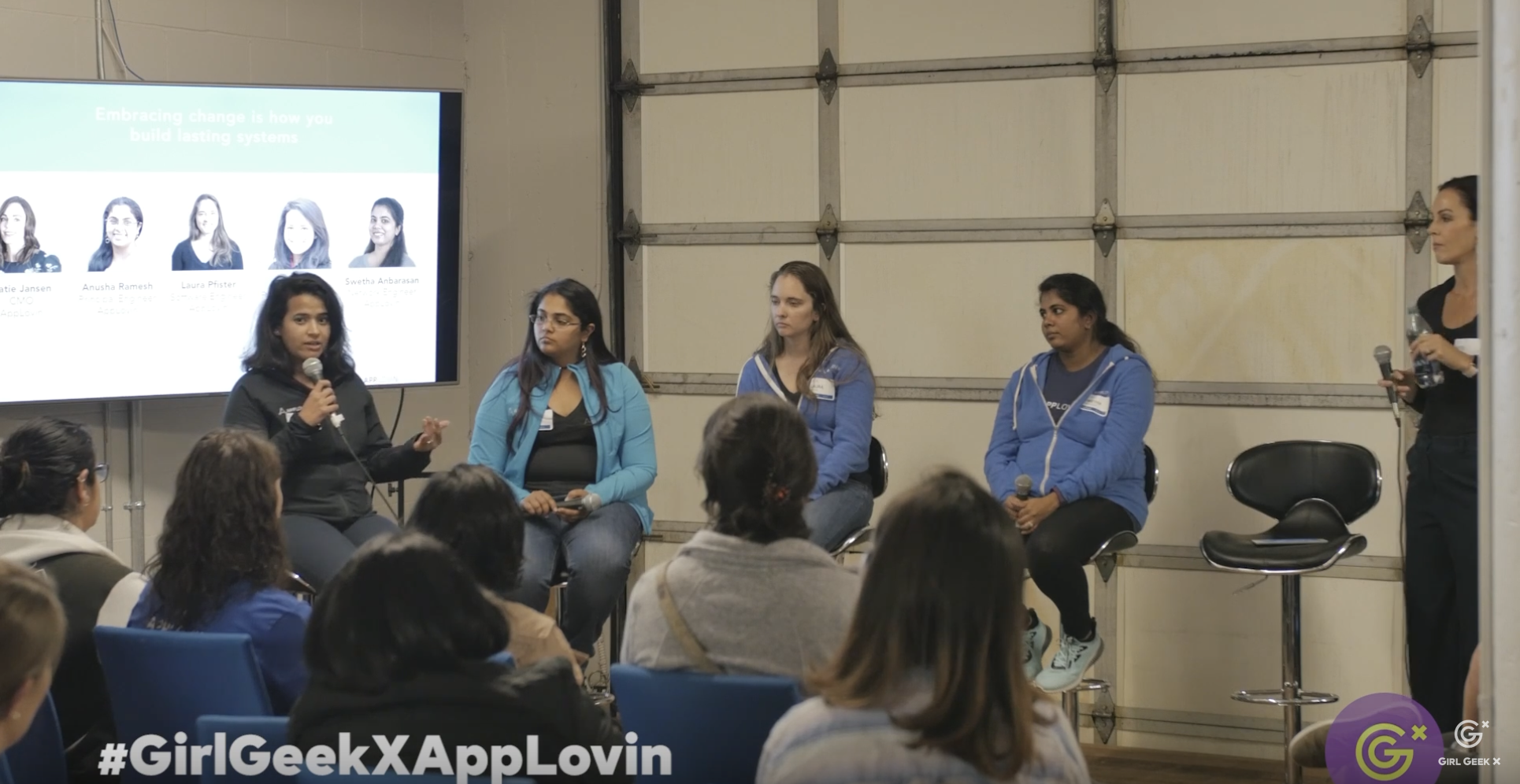
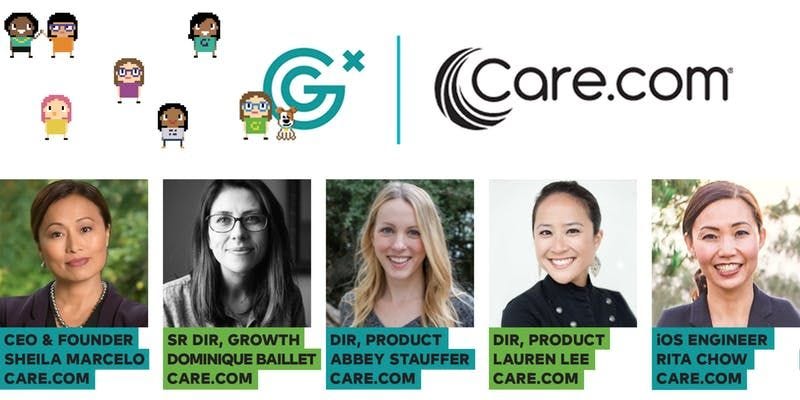
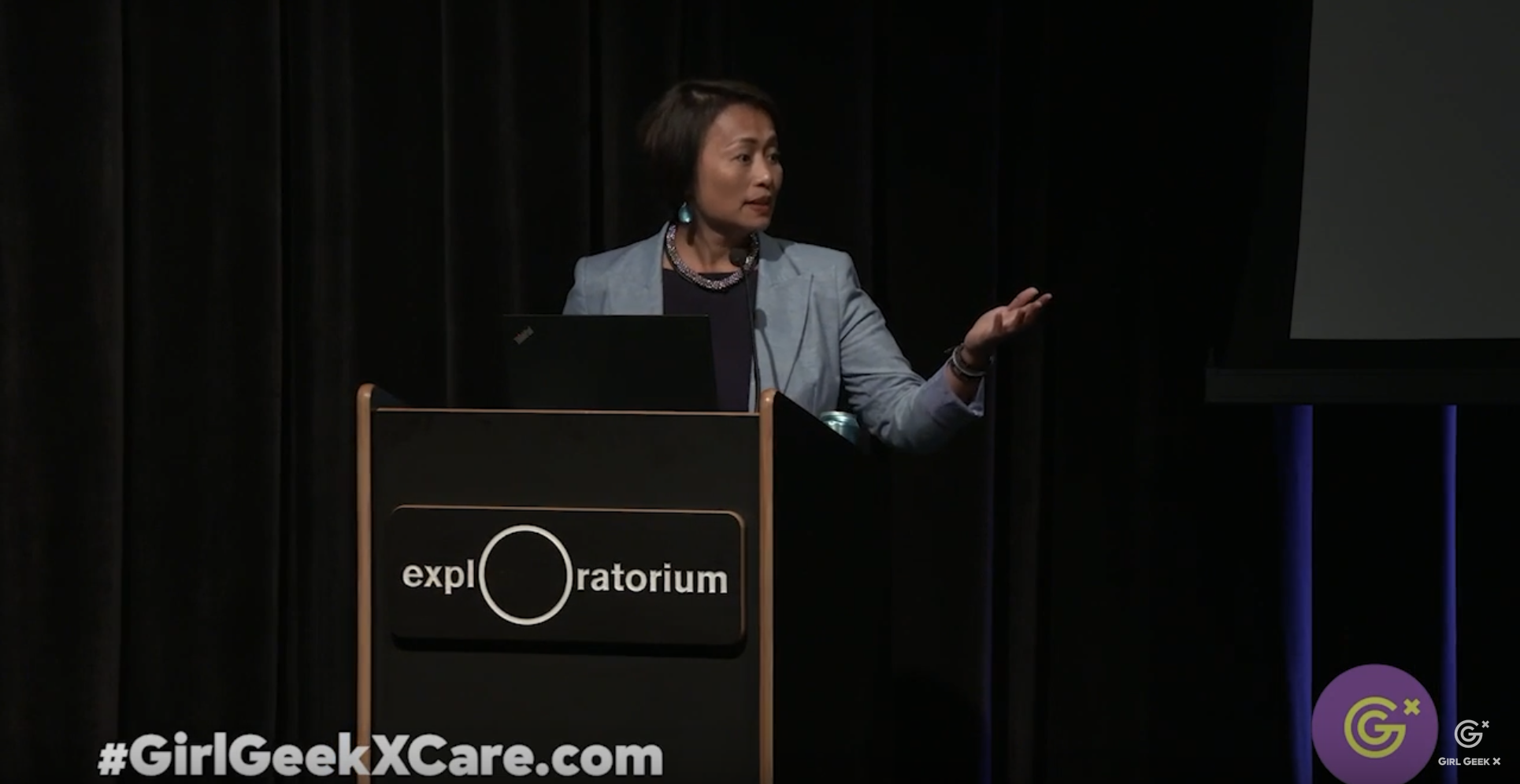
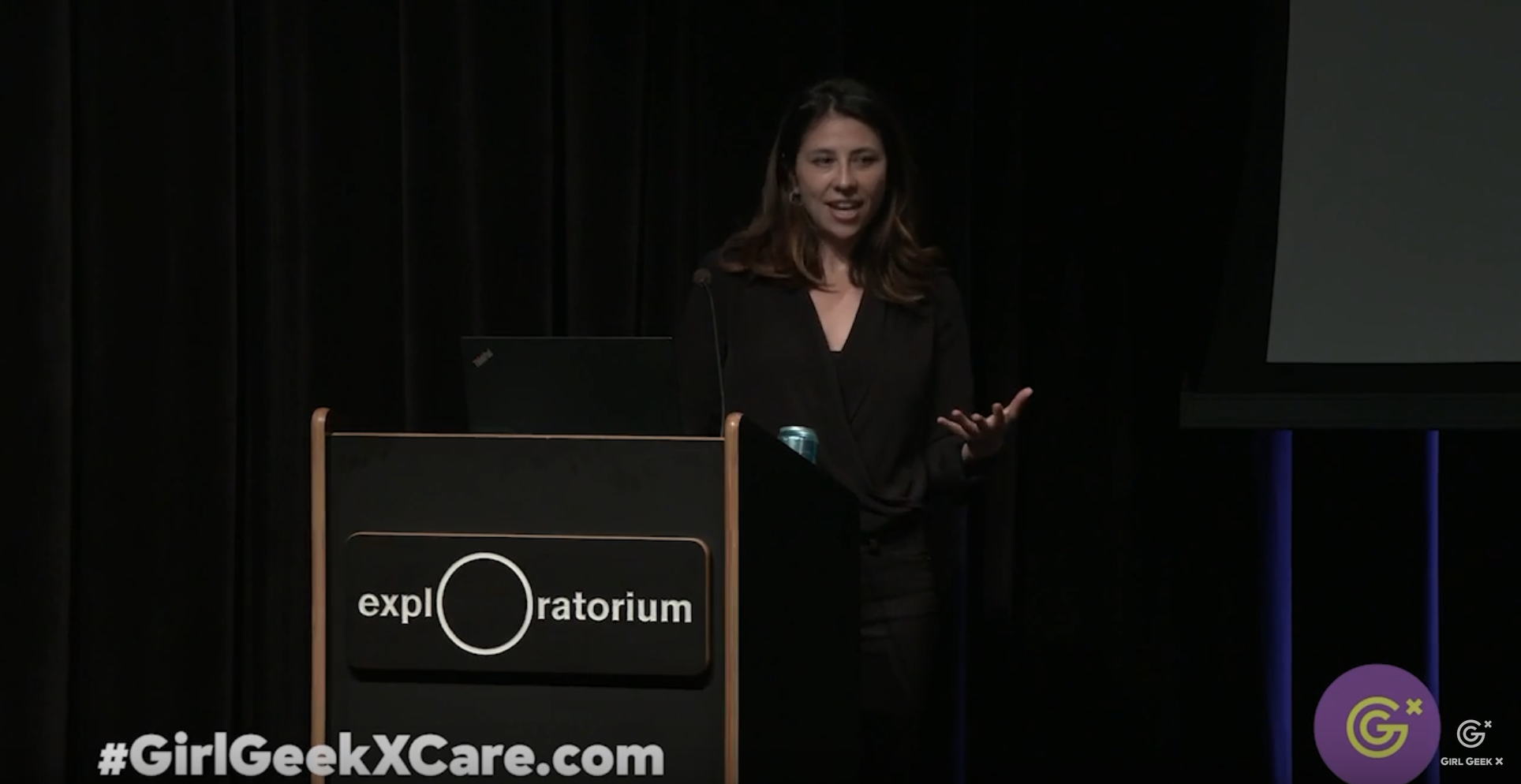
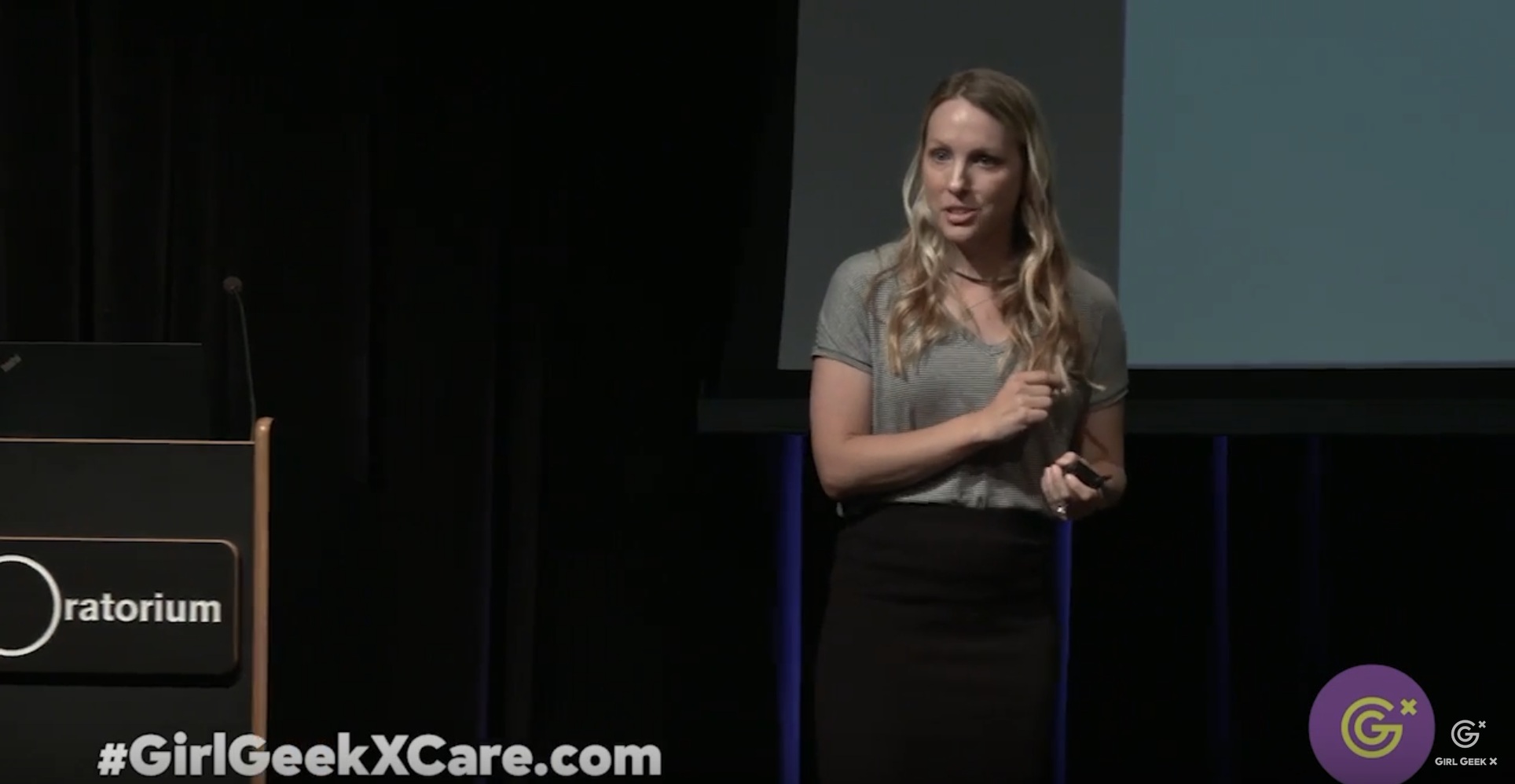
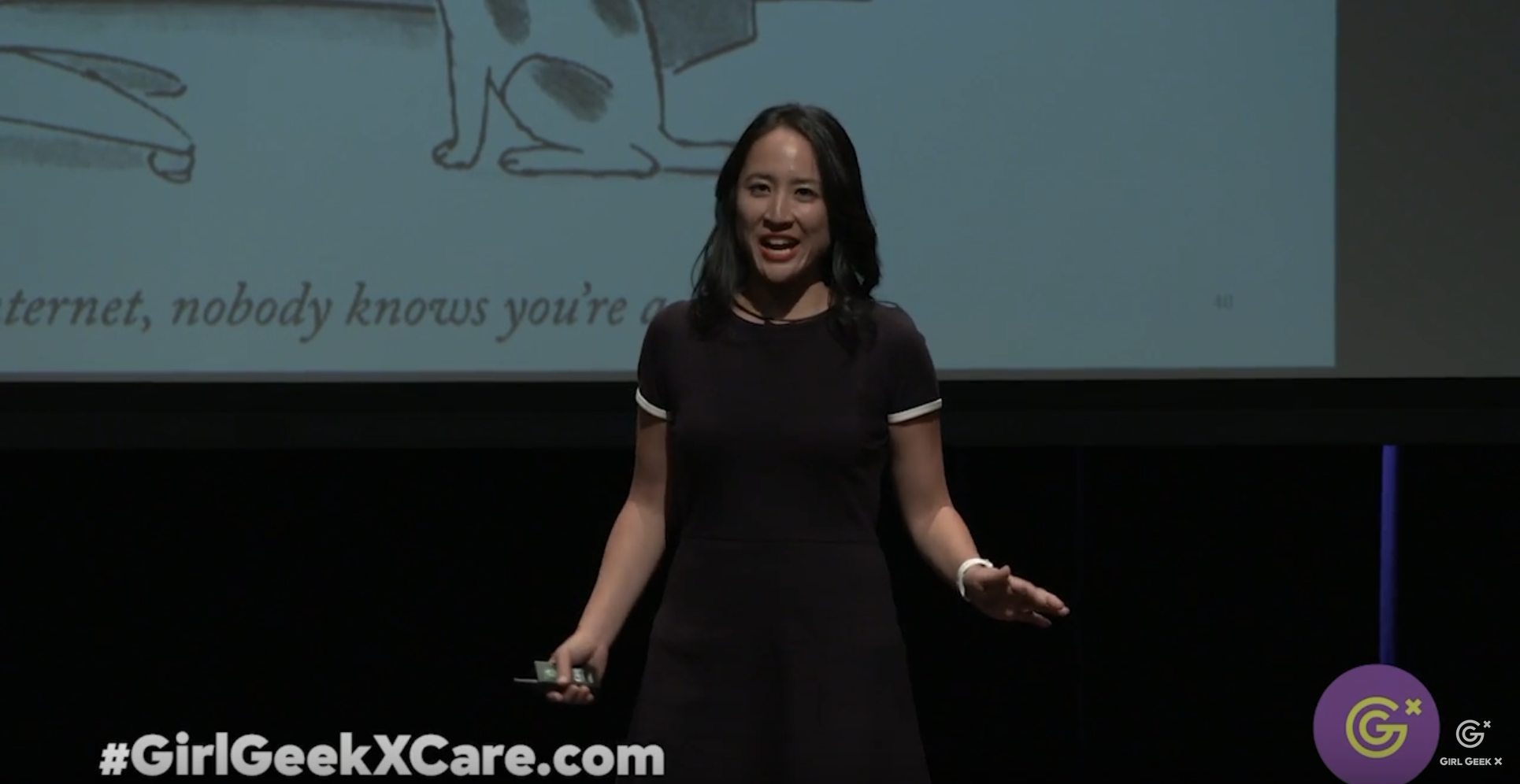
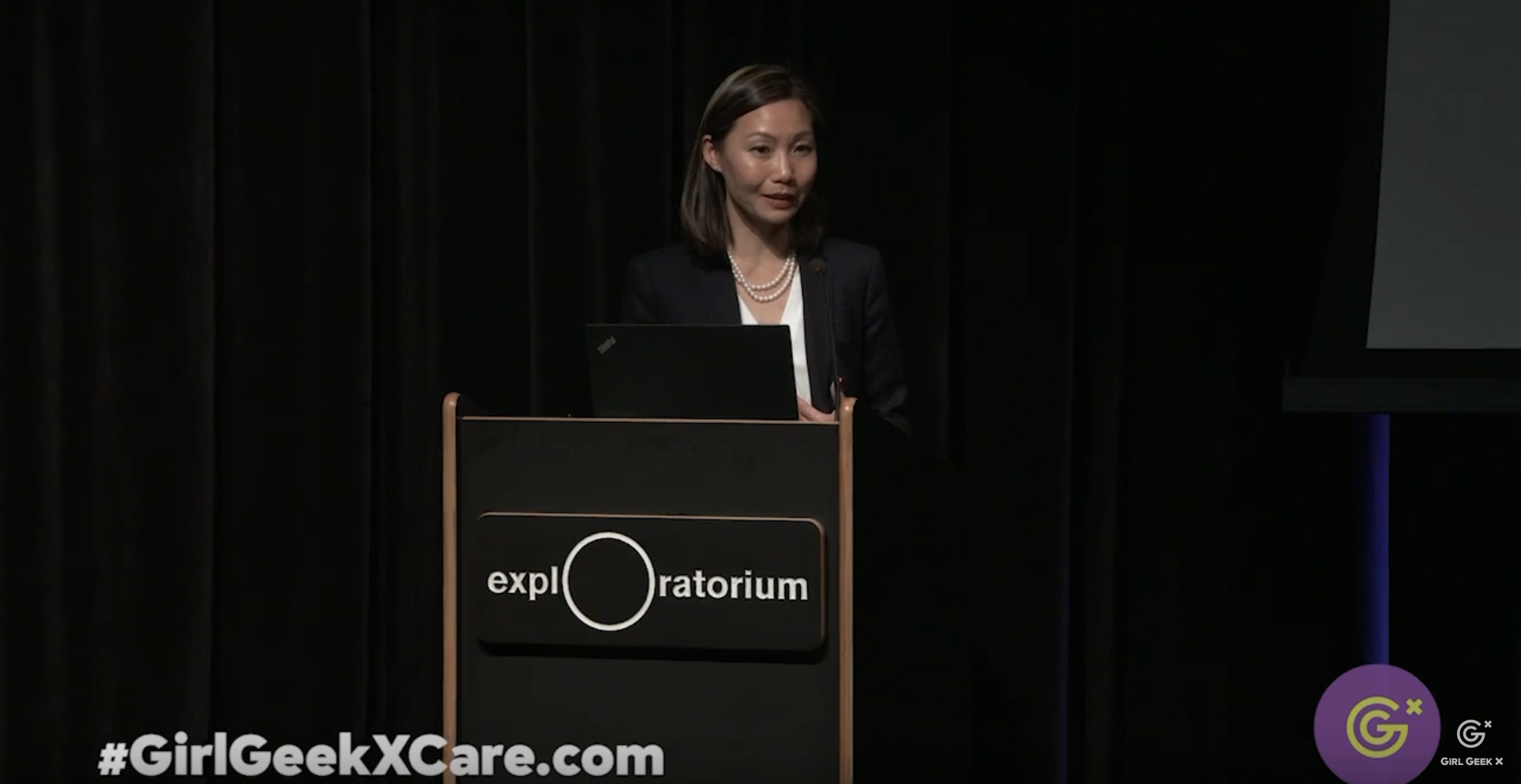
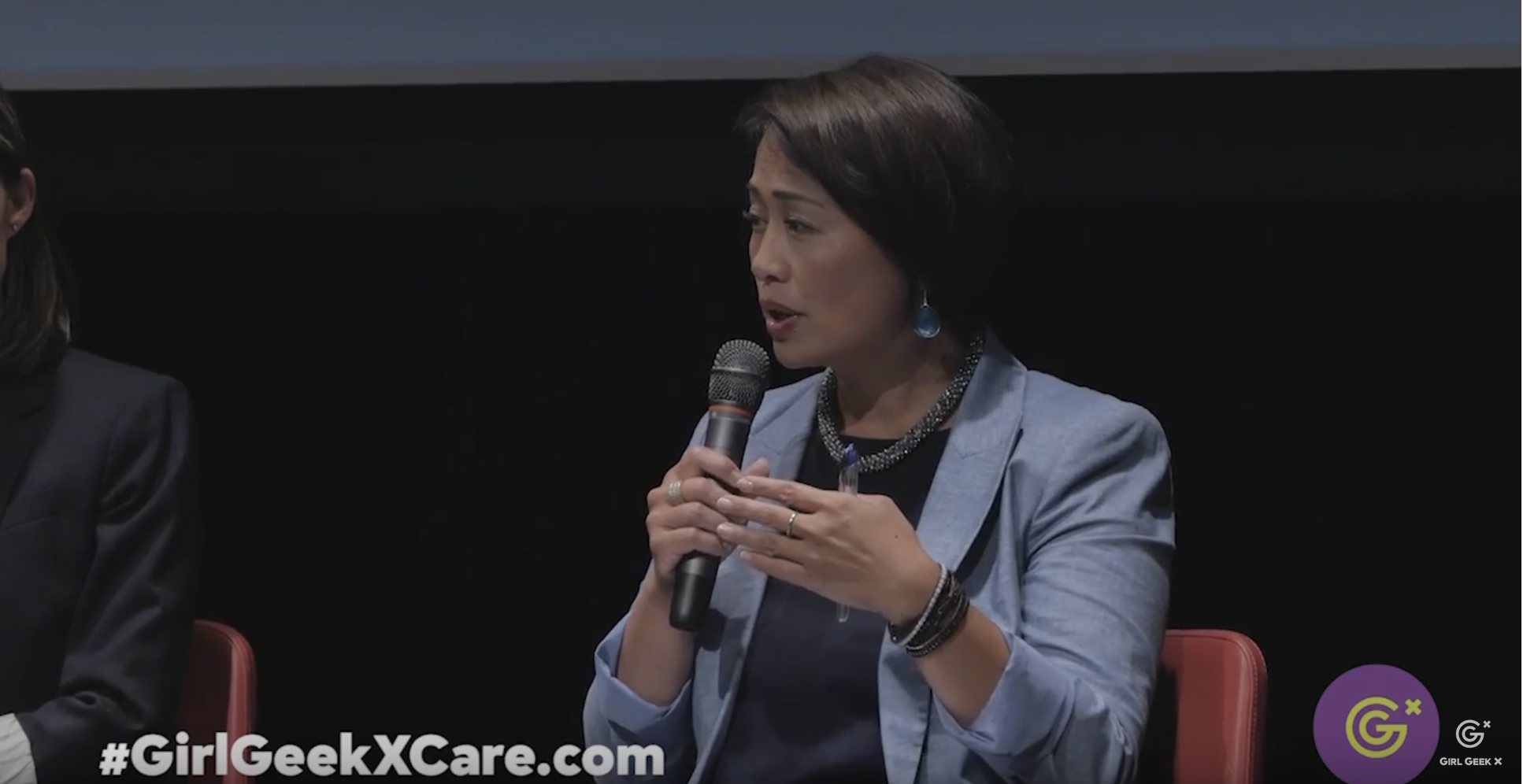

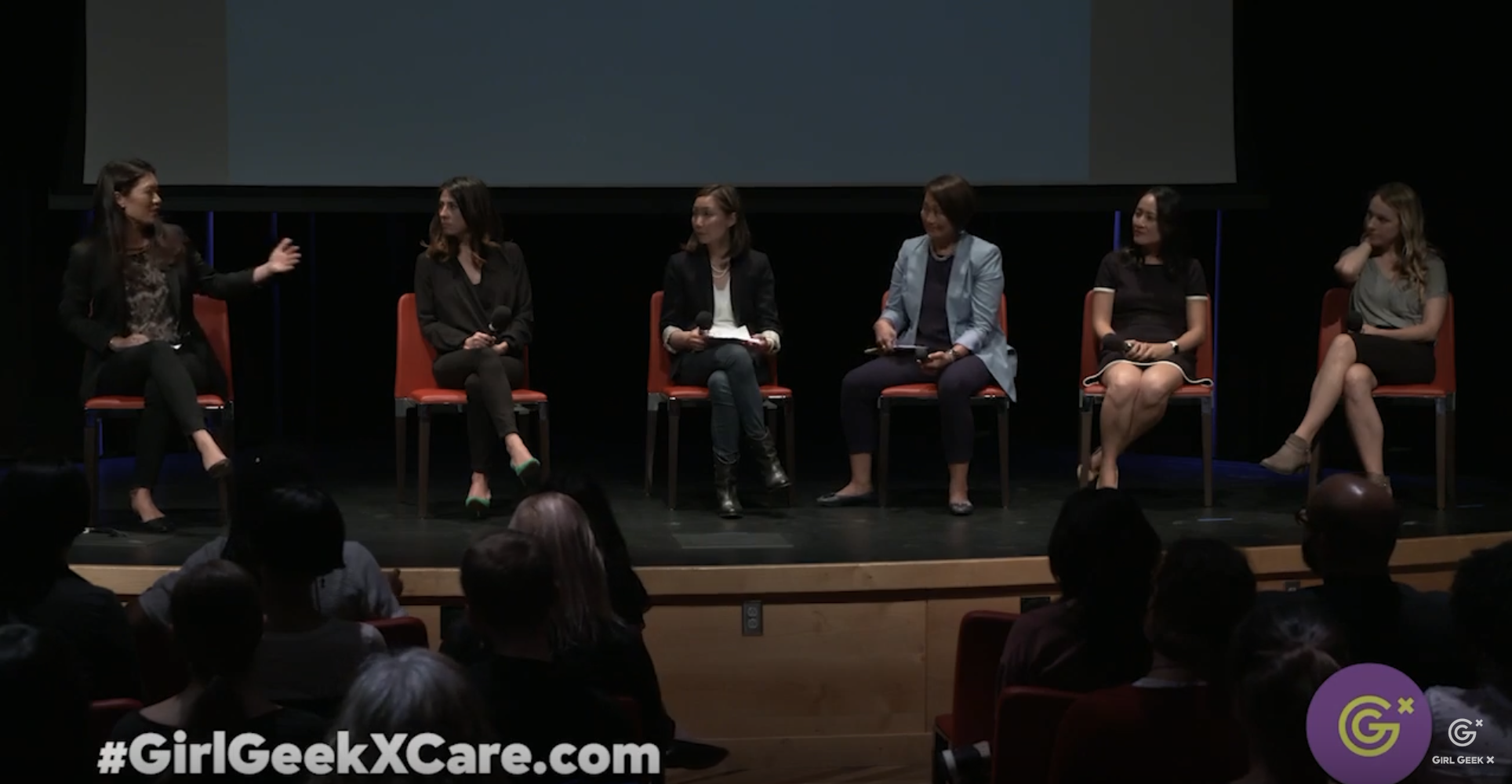
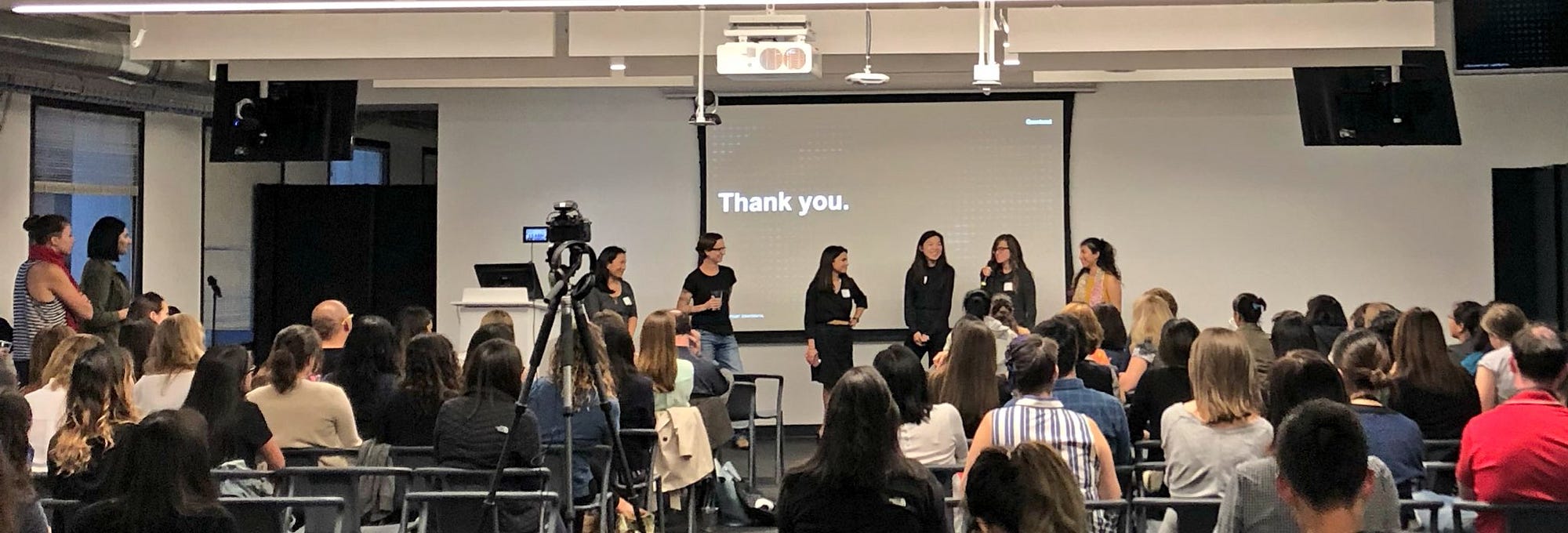

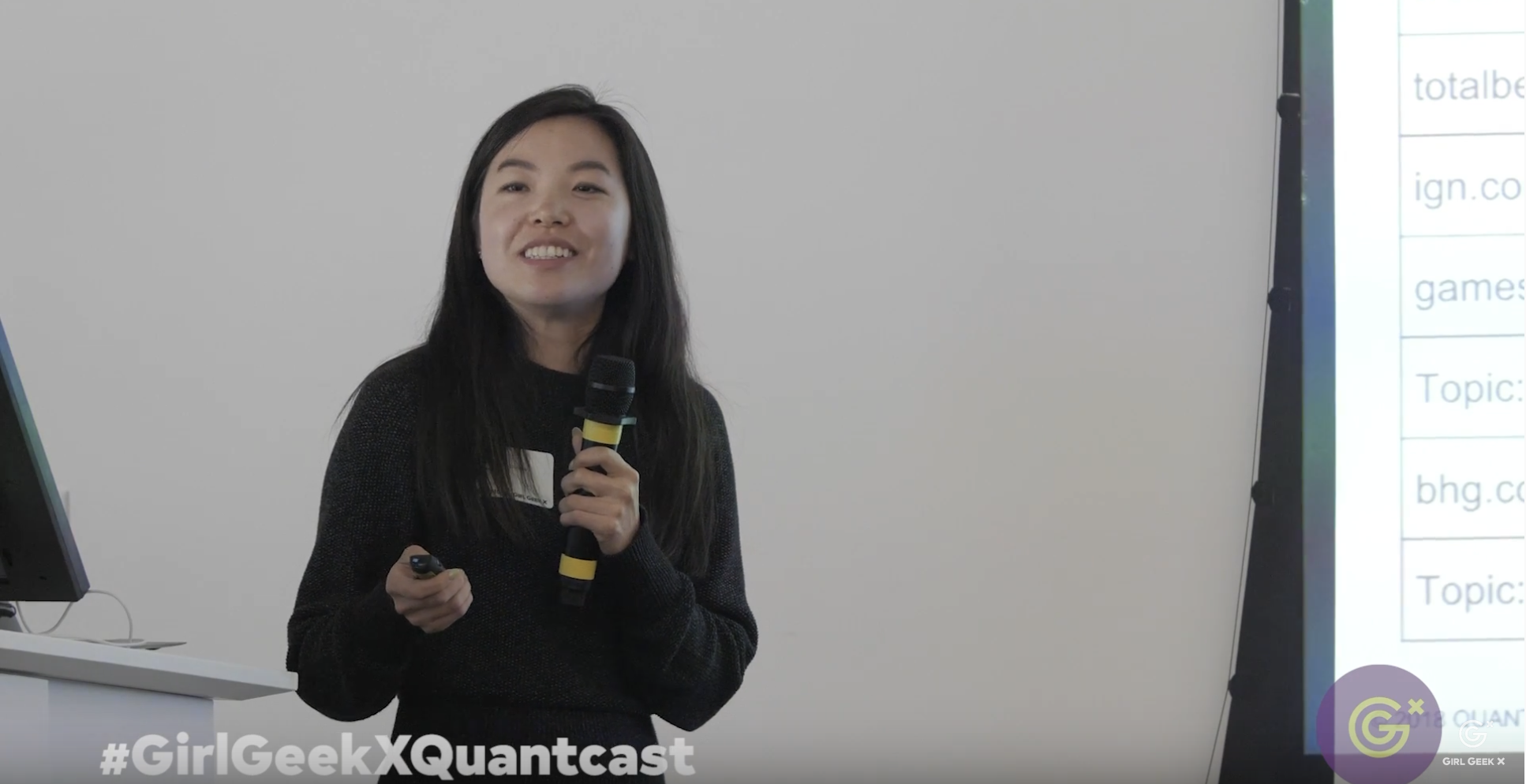
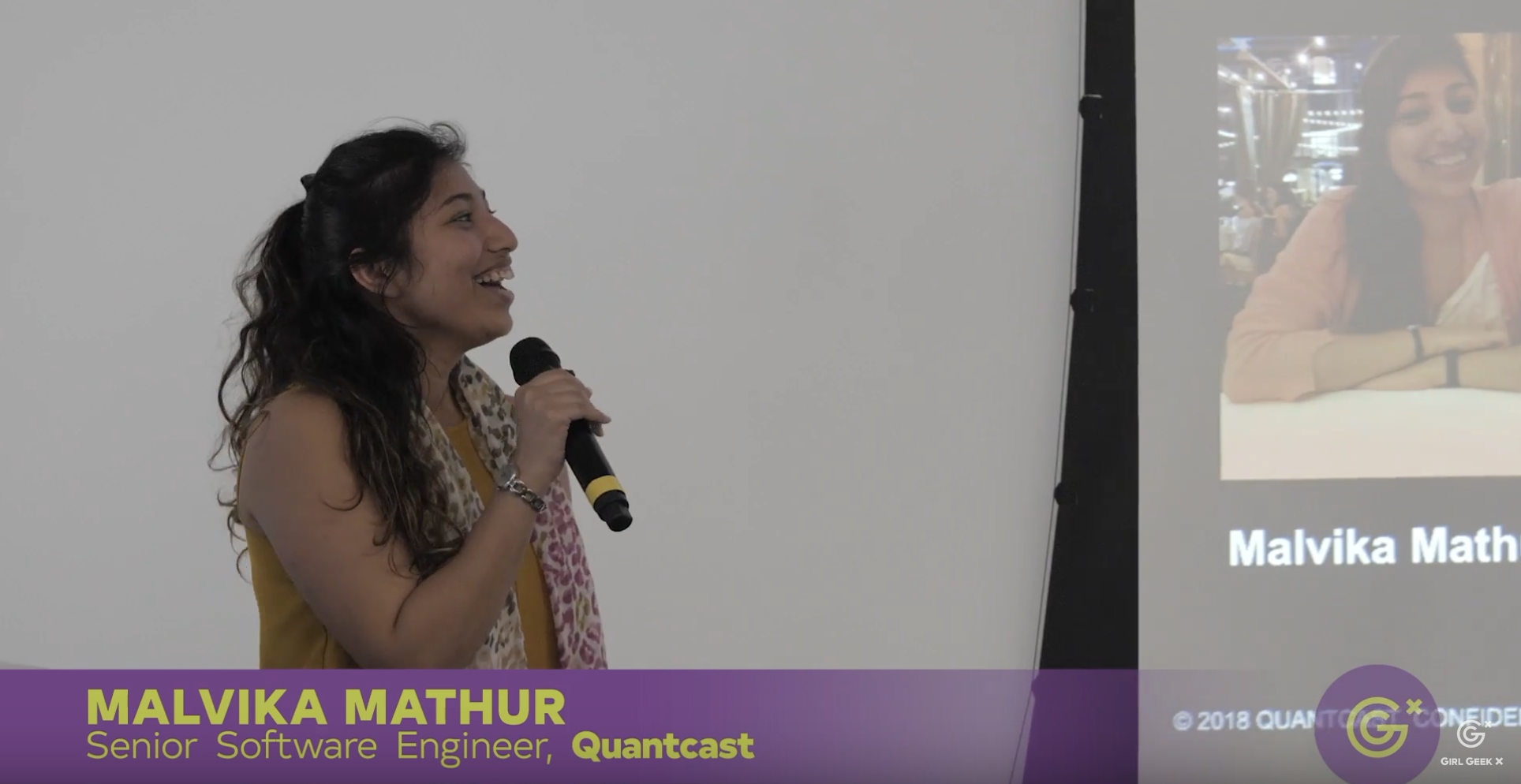
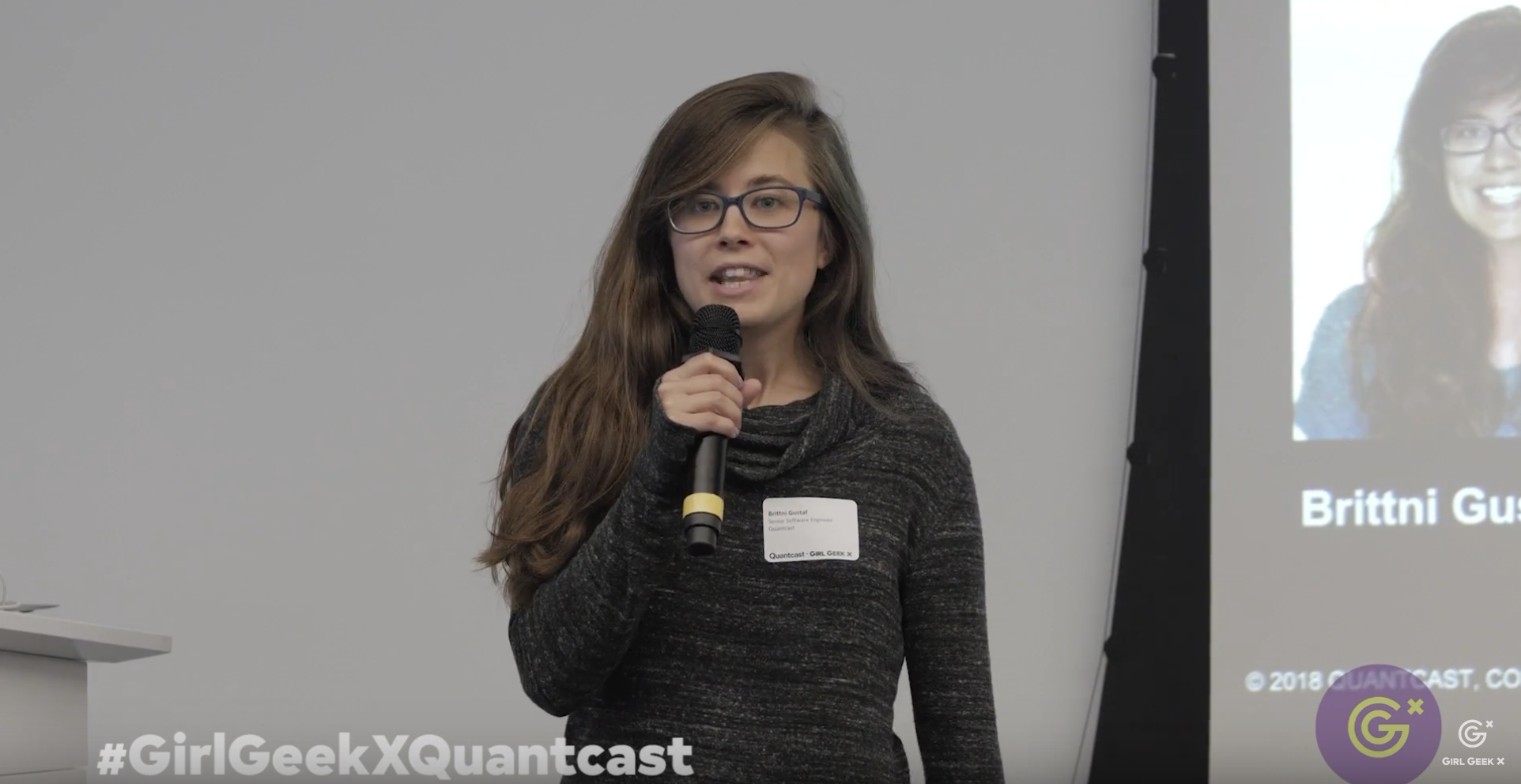
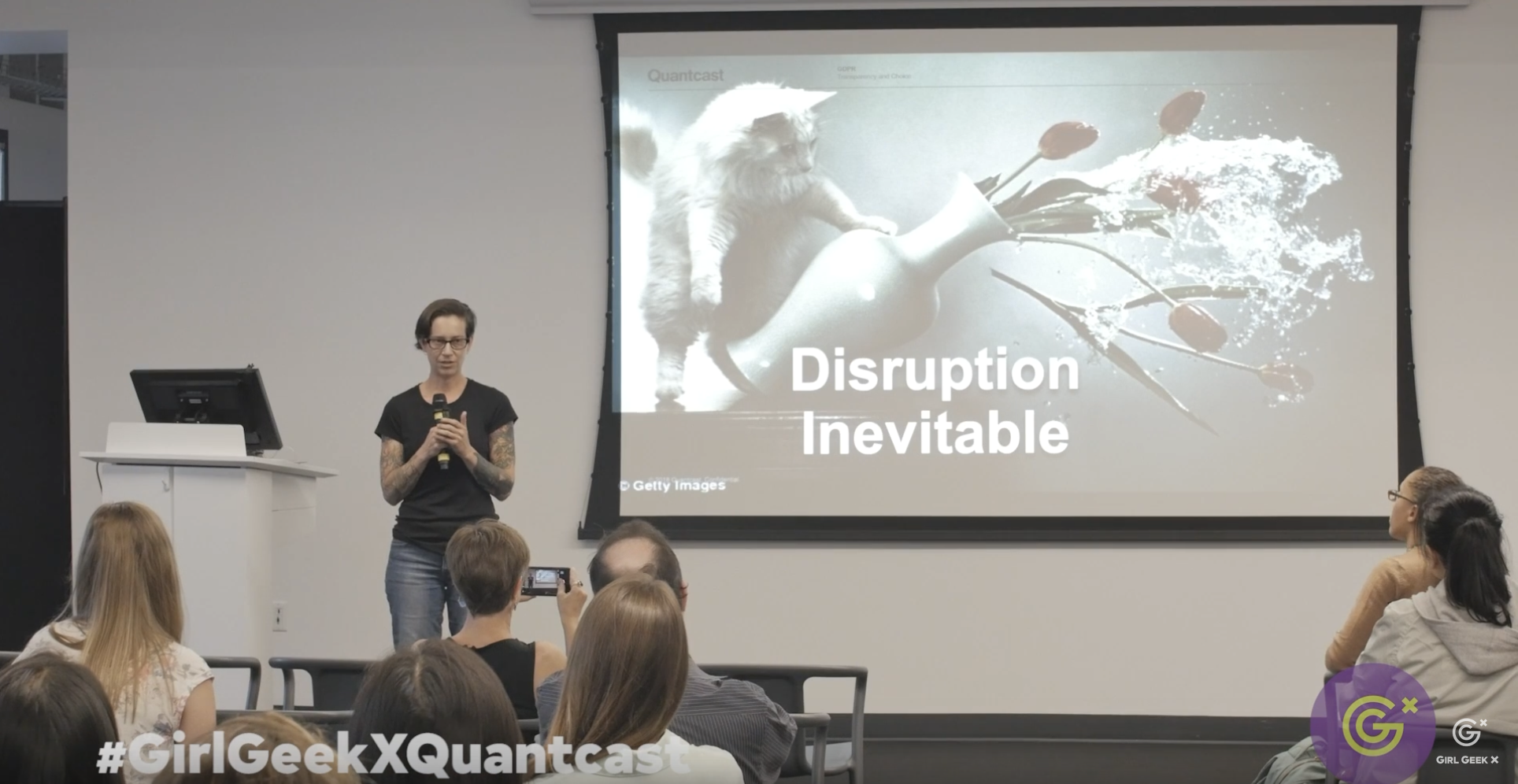
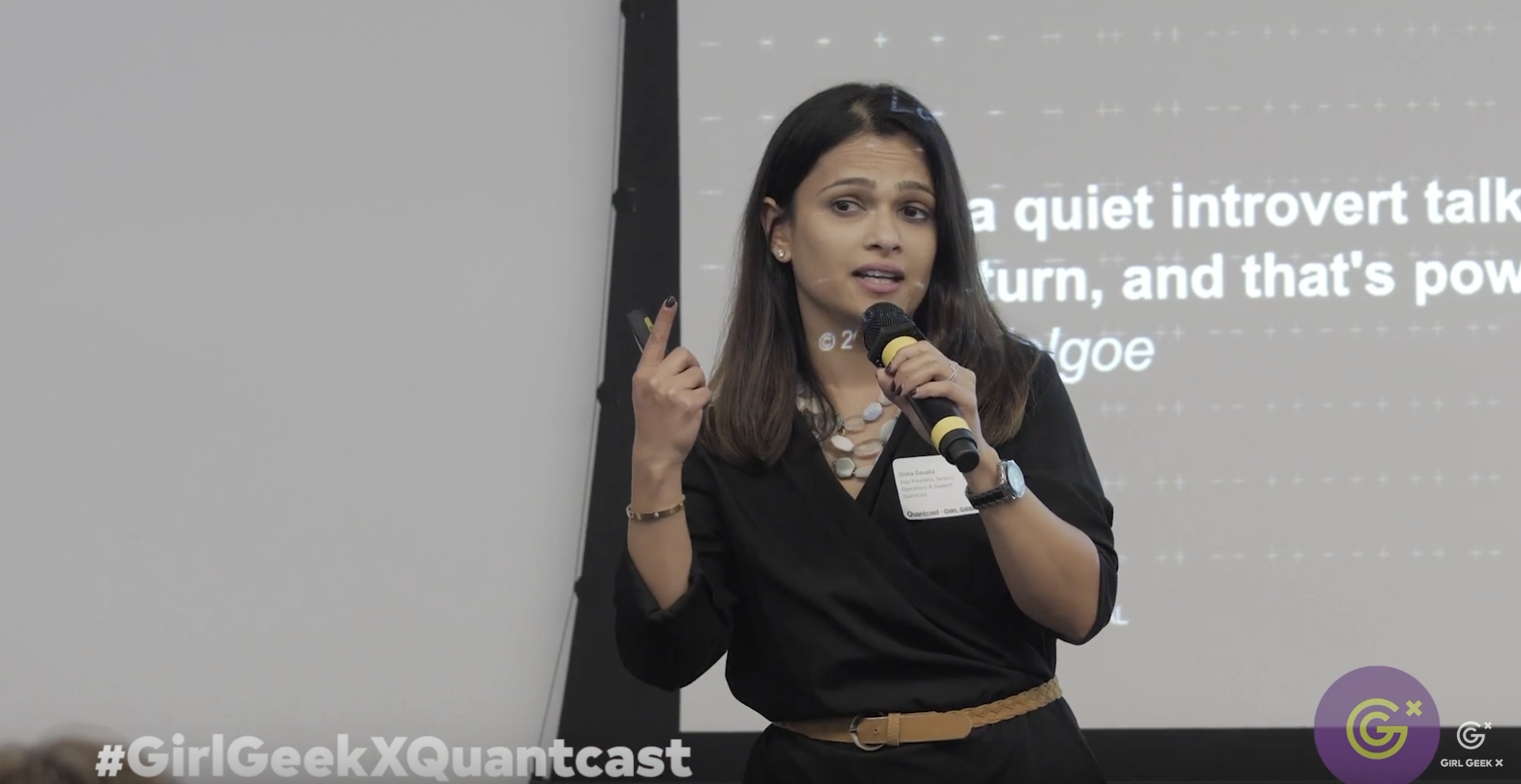
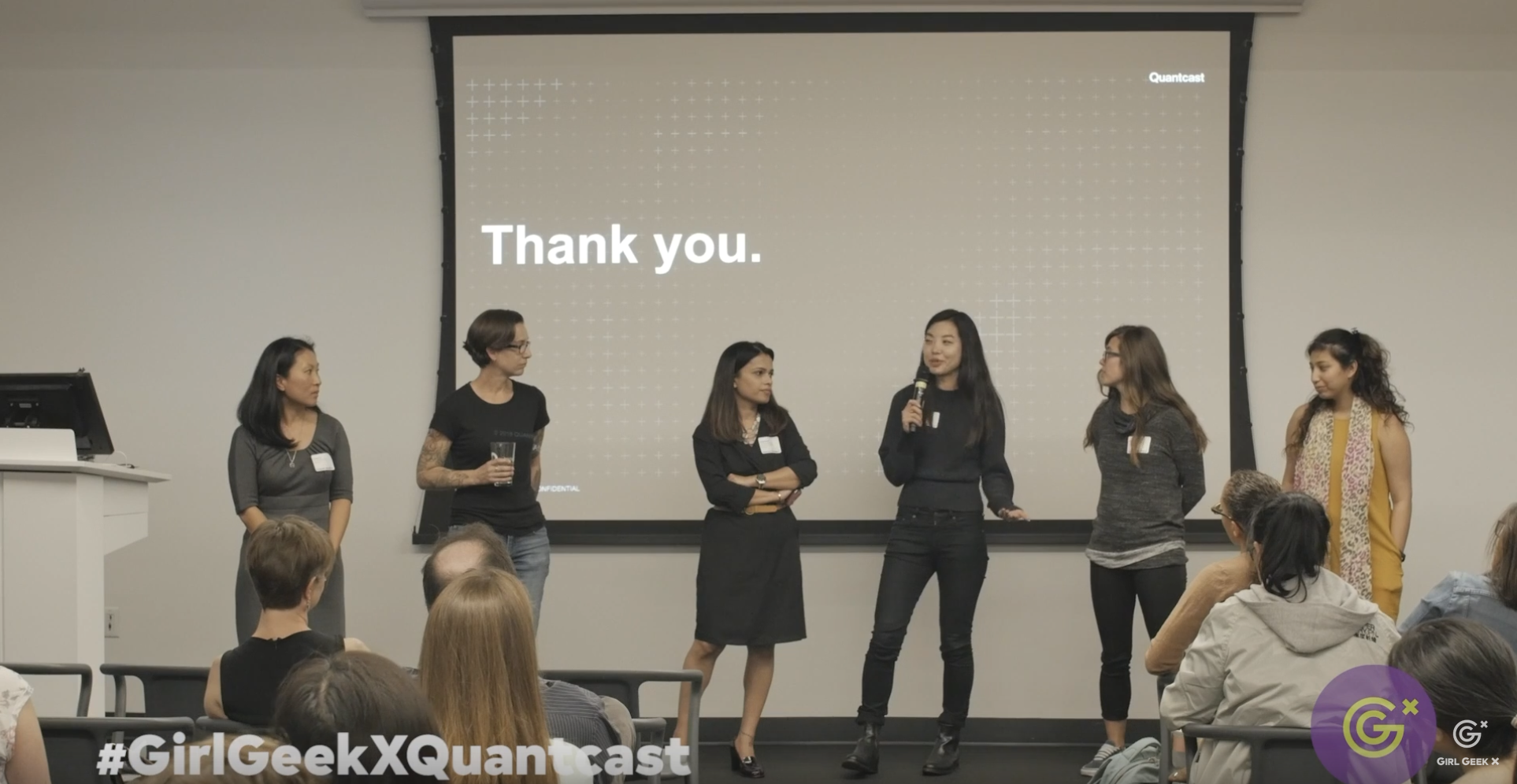
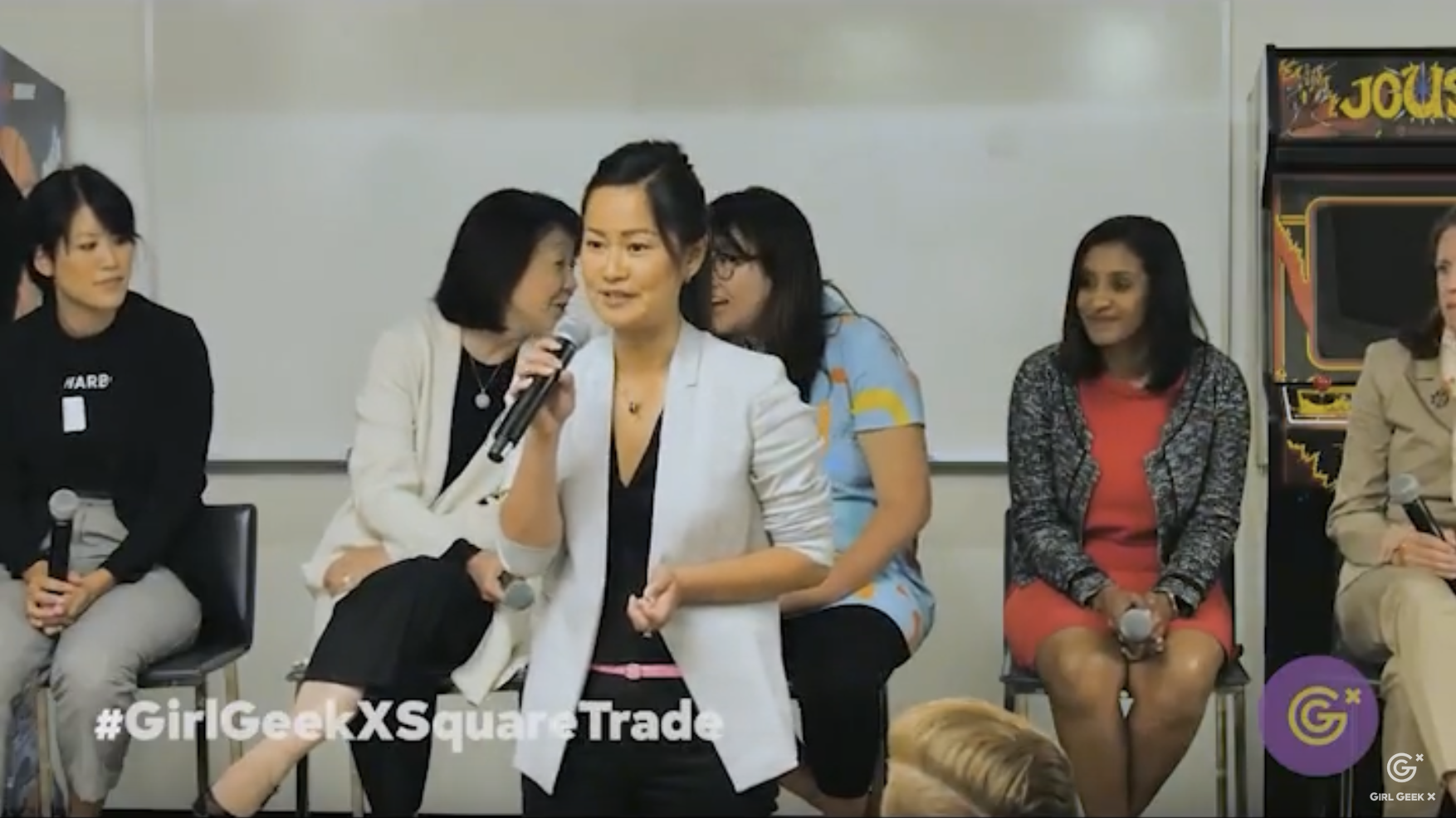
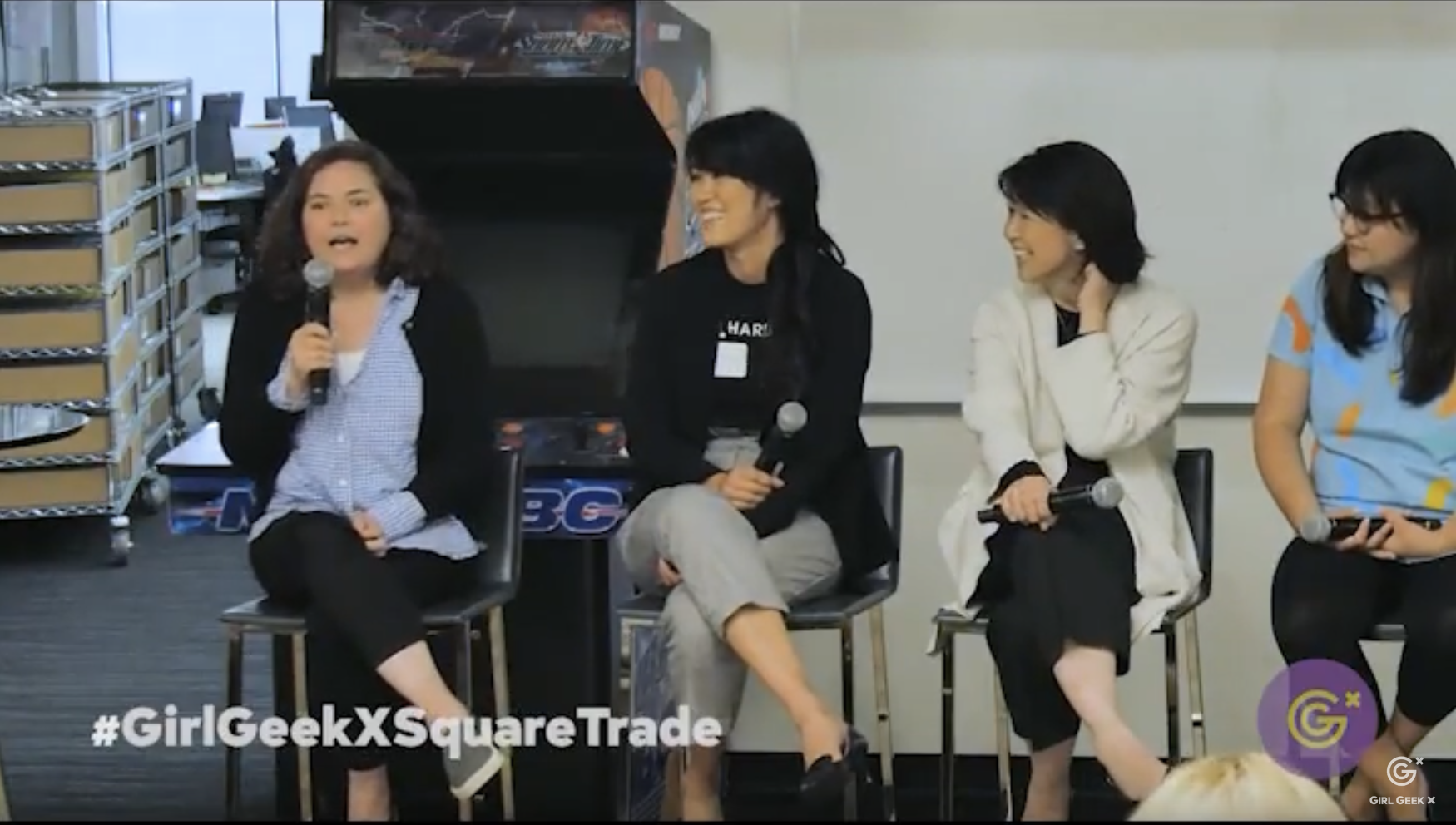
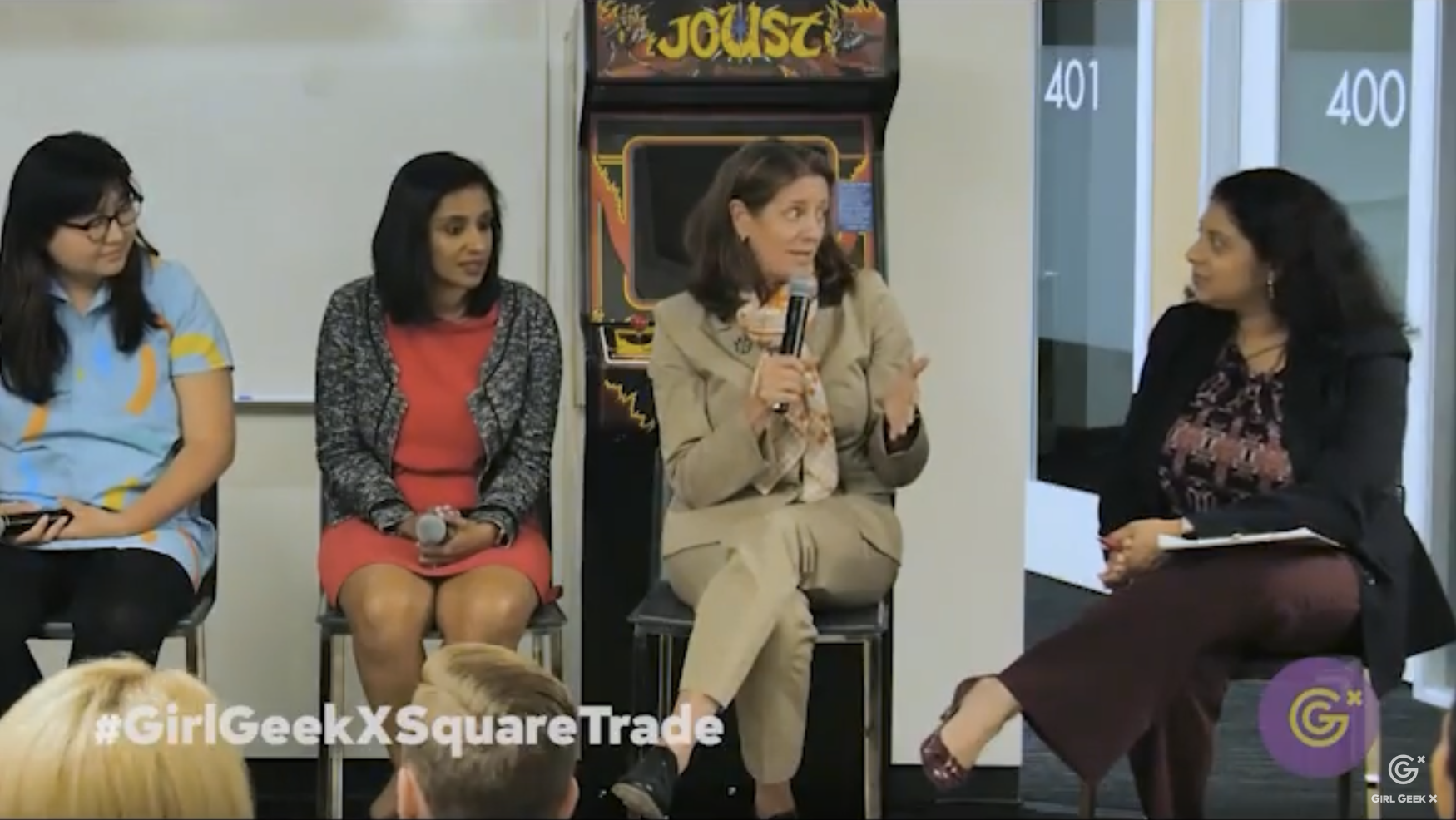
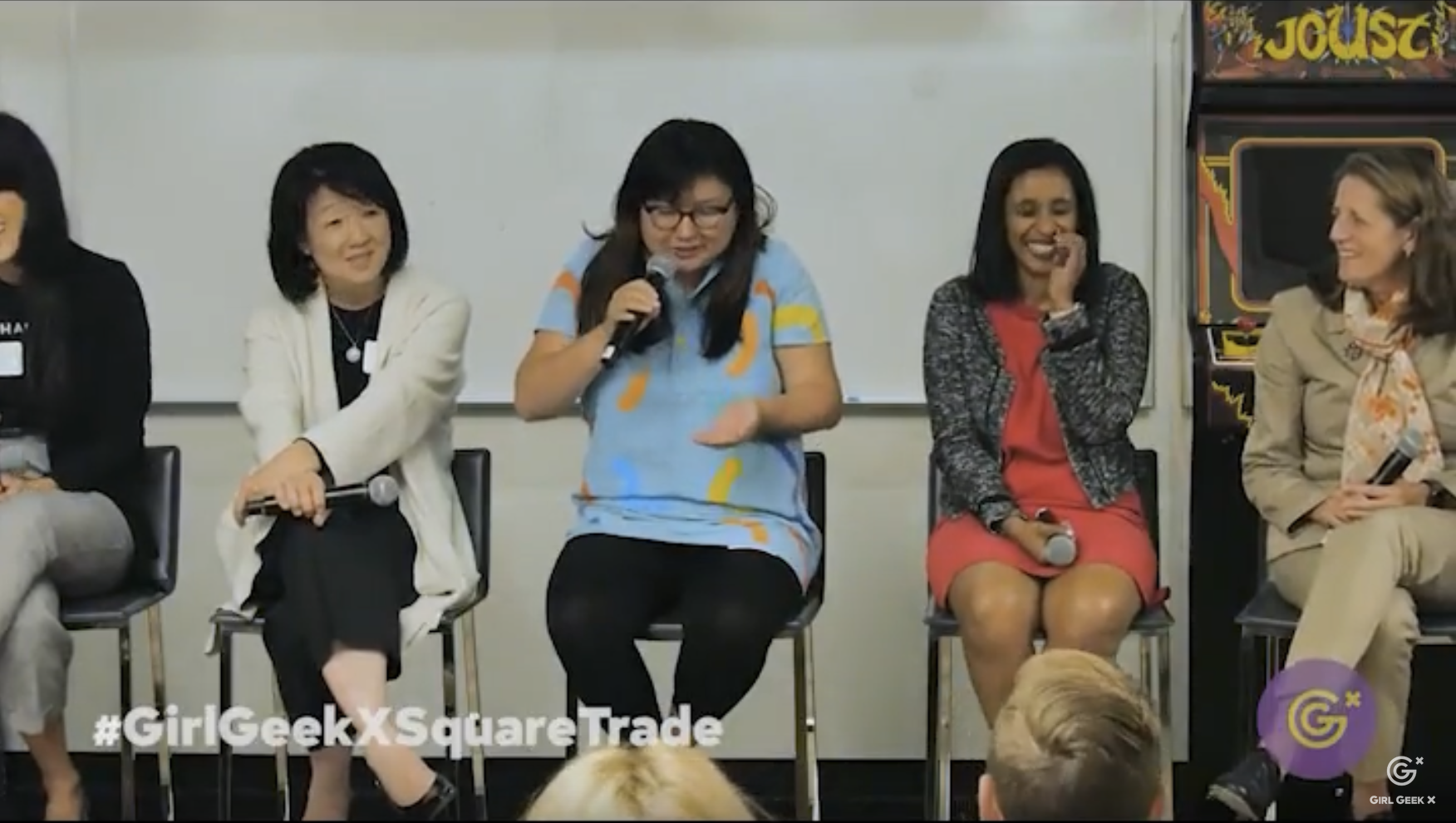
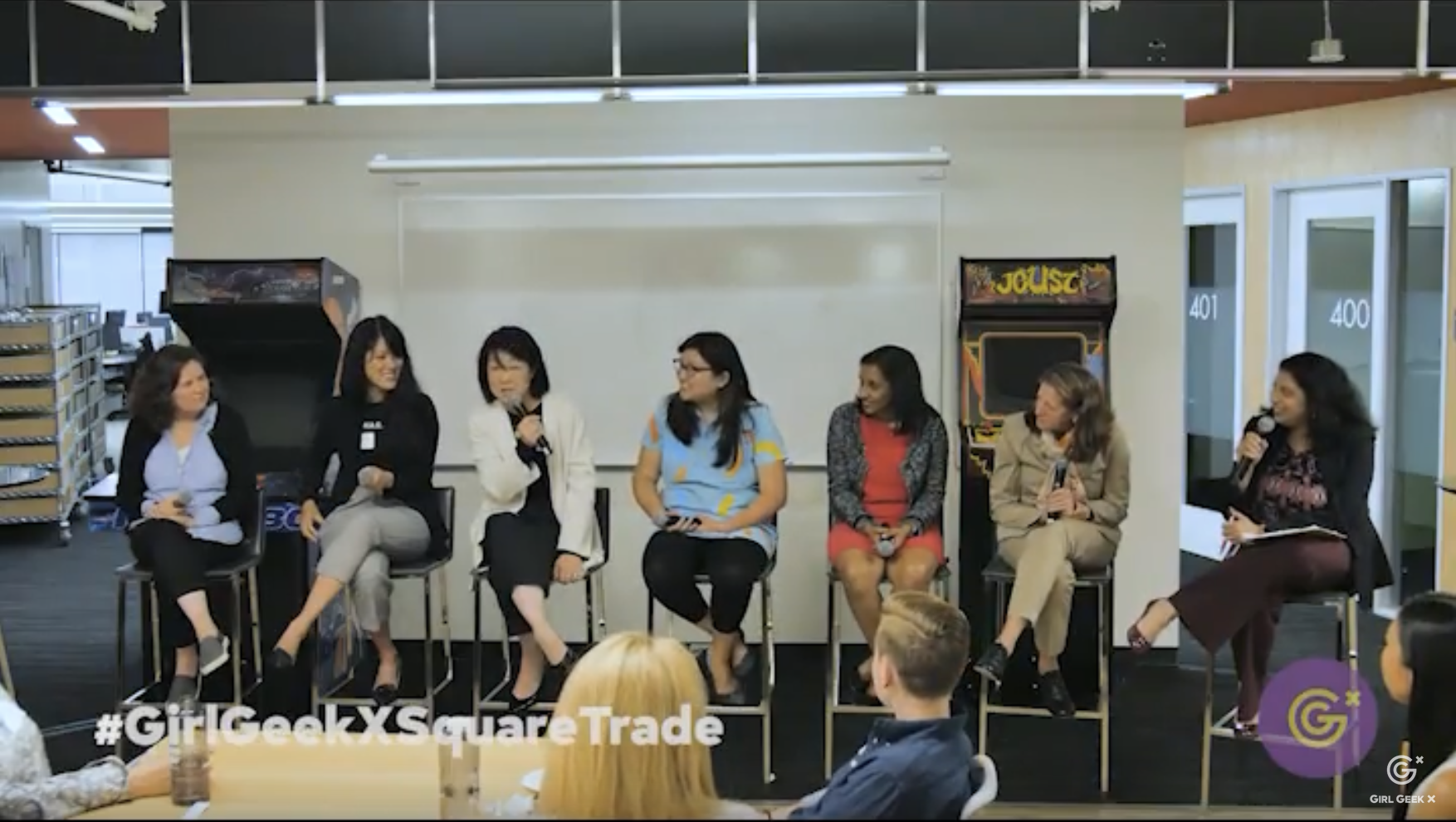
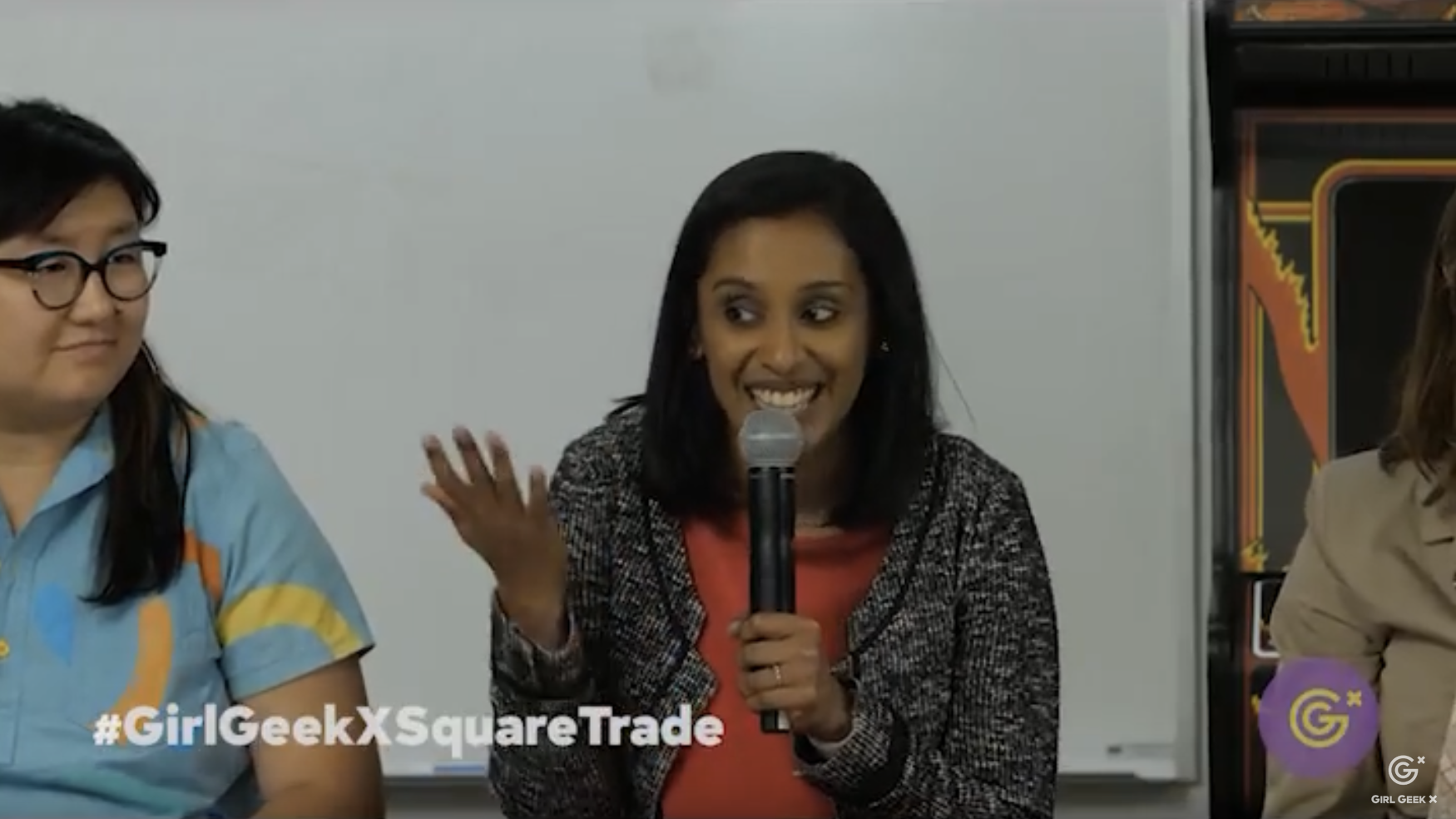

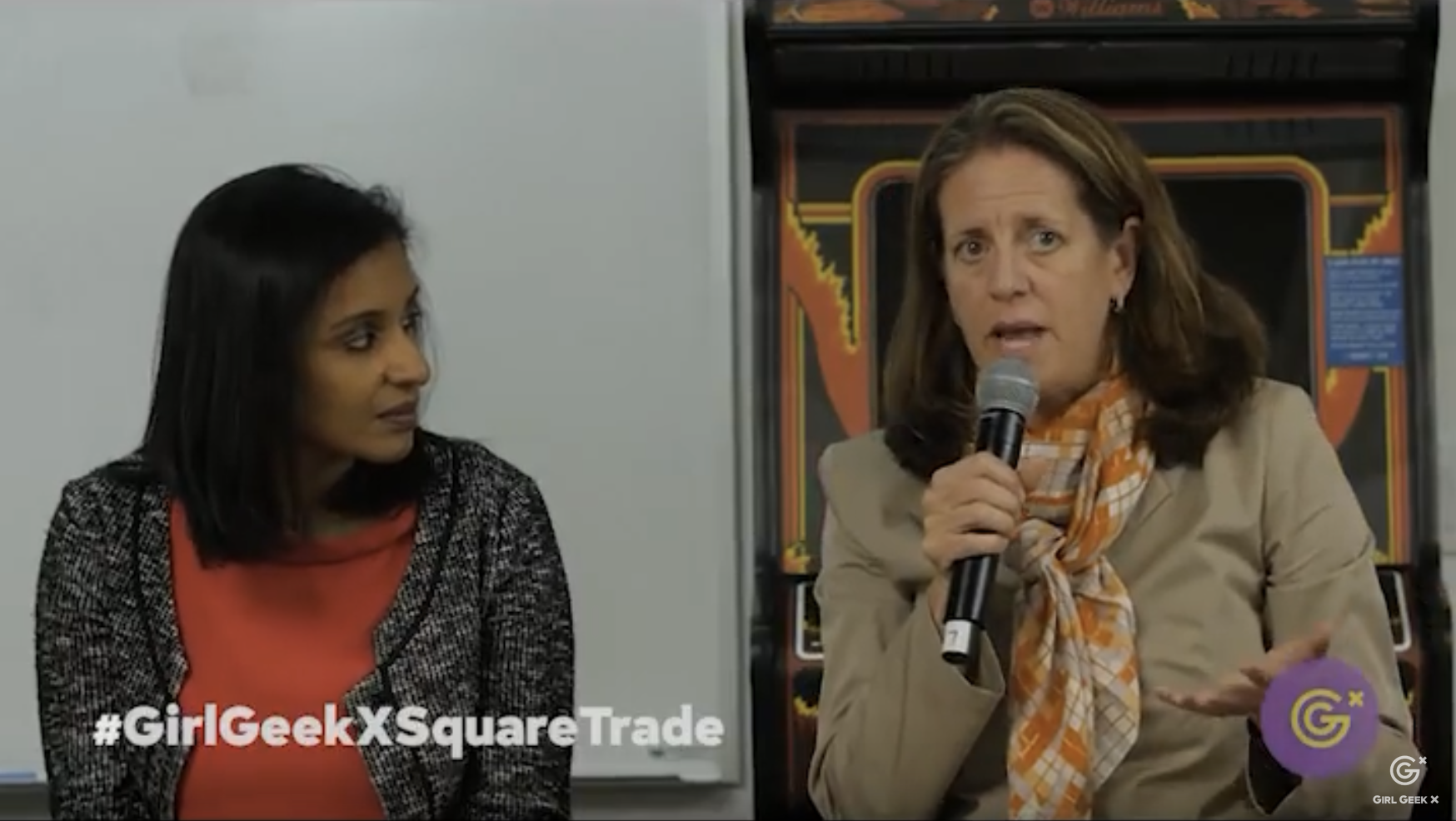
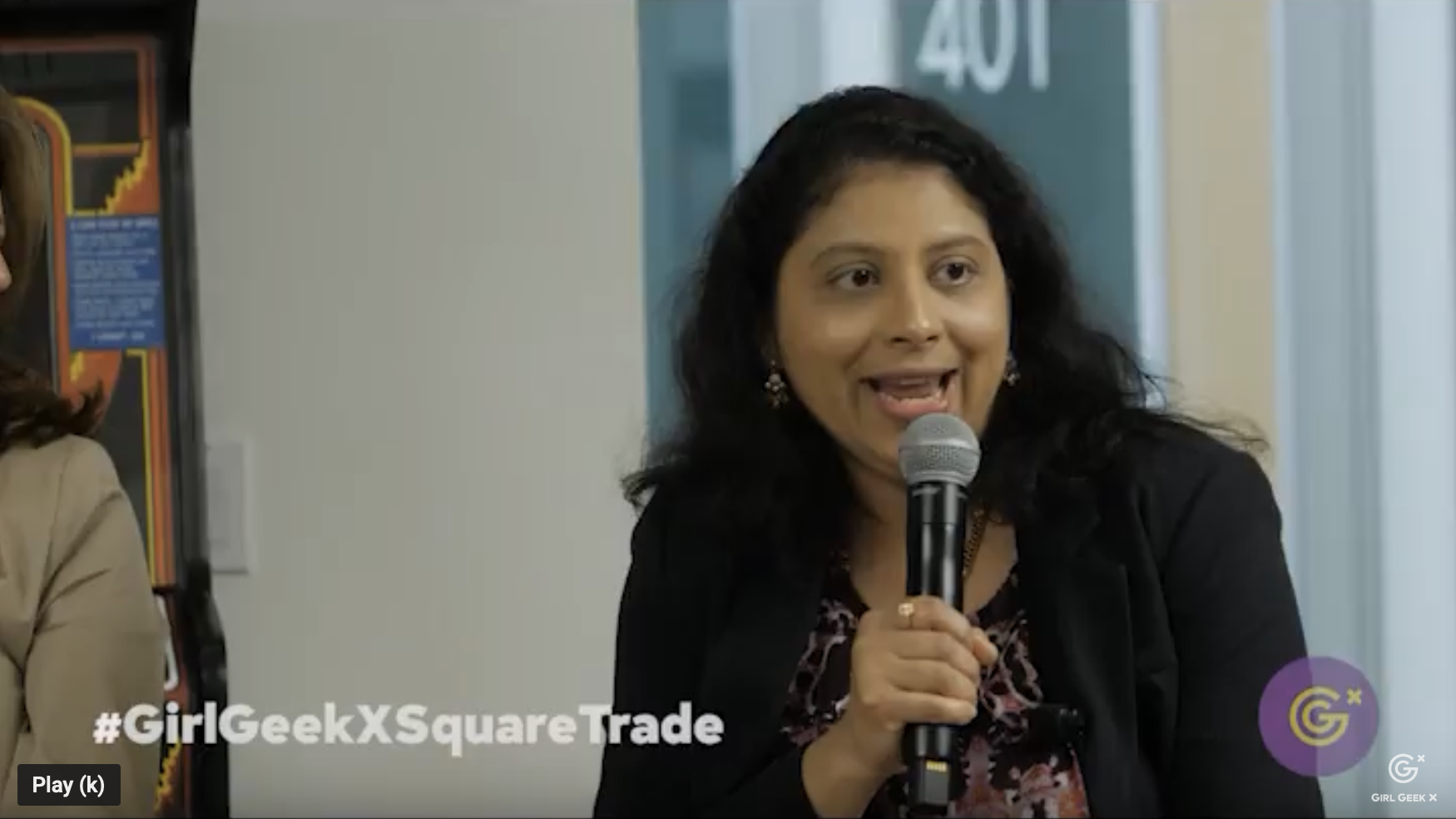 Wini Hebalkar speaking at SquareTrade Girl Geek Dinner.
Wini Hebalkar speaking at SquareTrade Girl Geek Dinner.